




As an industry, how receptive to change are we? A great question posed during an inspiring ten day trip to Los Angeles and one that’s quite nuanced in seeking an answer to.
Over the past two decades, the industry has overseen enormous technological changes which in many respects lead you to the answer that the industry is very receptive to new ideas, yet the business model has remained for the most part unchanged and some would argue that in recent years, we’ve become a little risk averse, although given what we’ve been through, it’s understandable.
As I tussled with this question, I was thrown another, when asked if, given the position we find ourselves in, as an industry are there too many screens. Of course, as a long serving employee of the world’s leading screen manufacturer, the answer is that we need thousands more, but seriously, it’s a really challenging question. Does the current business model require the volume of screens globally? Maybe not if you were to take the projection of a declining box office in 2024 (albeit with a reduced content flow) as the only backdrop, but are movies all we’re about? How do we maximise the tools
at our disposal (content, assets, technology and infrastructure) to drive efficiencies, revenue and indeed audiences and can we do more?
Whilst the extensive and expensive infrastructure of our industry is incredibly costly to upkeep, it was designed with convenience, capacity and efficiency in mind. The global footprint of cinemas affords us with the space to provide different and unique experiences to consumers (not just movie-goers) and to utilise that to grow back our core business. Those that have wider programming that encompasses event cinema and local content appear to be performing better and will likely end this year in a stronger position.
As we head towards our two biggest industry gatherings in CinemaCon and CineEurope, this issue will hopefully leave you inspired that despite the current challenges we face, there are boundless opportunities that are both exciting and potentially transformative.
Some of those opportunities don’t have to be huge capital investments either. At the high-end of investments, we showcase consumer experience with the visually and technologically impressive The(Any)Thing Cinema in the Netherlands that combines comfort with on-demand technology, the equally brilliant US-based Cinergy

Entertainment providing mixed-use entertainment venues with dine-in options and Cinity from Christie. But we also showcase some of the lowercost quick wins that can help drive efficiencies and audiences including The Hangar from PaperAirPlane Media that is helping studios, distributors and US-based exhibitors to standardise and leverage digital marketing assets to amplify movies.
We also investigate how to utilise authenticity in marketing to build brand affinity and audiences and how use of automated lighting technology can create more impactful pre-show experiences which in turn can help leverage more in-theatre advertising and much more.
Perhaps rather than asking how receptive to change the industry is, the better question is, are we able to collectively evolve quickly enough to meet ever changing consumer expectations?

20
07
11

34
14 Cinema's
23
26

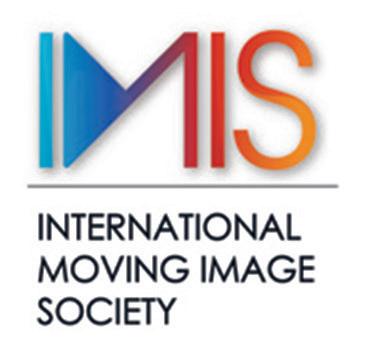

CTC
ART
ADVERTISING:
30
California-based PaperAirPlane Media is transforming the digital marketing asset distribution space in the USA.
34 Markus Overath continues his practical guidance on seating focusing on planning, sight lines and style.
39
42
From Cinity to Infinity. A look at Christie's PLF offering.
What's the future for cinema advertising? Jan Runge investigates.
49 4D experiences by award winning Argentinian manufacturer Lumma.
54 A look at the technology upgrades to Channel 4's screening facilities.
58
62


Up-to-date round-up of the global industry newS, views & events Up-to-date round-up of the global industry newS, views & events
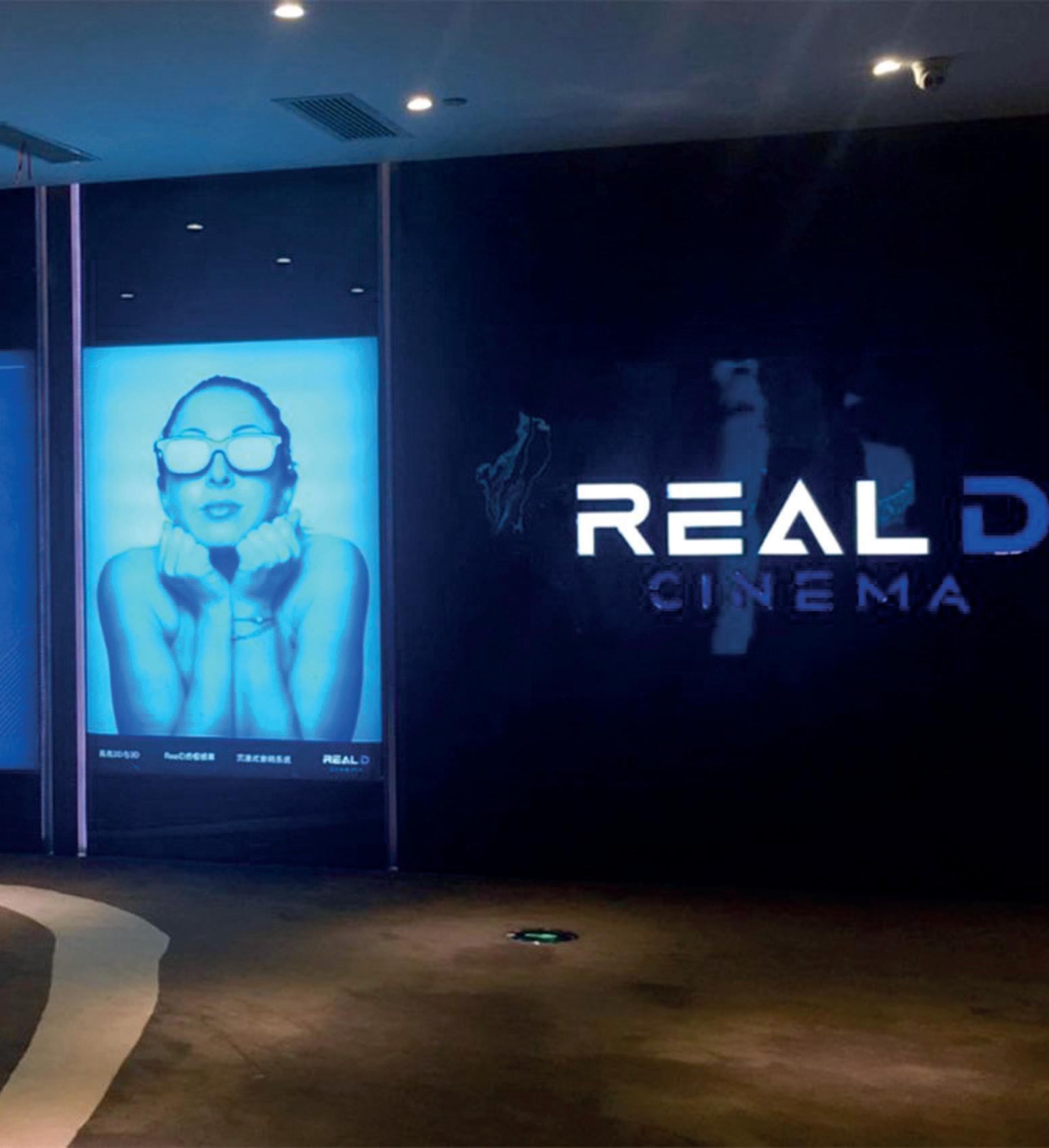
GLOBAL visual technology leader RealD Inc. recently announced that the China National Intellectual Property Office (CNIPA) has ruled in favor of RealD, rejecting all three Shenzhen LeVision Global Technology Co., Ltd.’s requests to invalidate RealD’s Chinese patents.
LeVision’s three invalidity challenges to the RealD 3D® dual-beam and the threebeam optical system patents were all rejected, confirming in full the validity and integrity of the invention patents of RealD 3D® projection system in China.
RealD’s three Chinese invention patents are ZL201310233906.3,
L201480000777.6, and ZL201710333855.X.
These patent challenges are the second time an individual or company has filed an invalidation request against patents owned by RealD 3D® regarding their three-beam optical technology in China. All requests to date were denied.
This victory is also the latest case upholding and affirming RealD’s patented technology in the world. In 2018, the European Patent Office (EPO) rejected both Volfoni and MasterImage’s European patent invalidation challenges against RealD, and the validity, scope, and rights of RealD 3D® system remained
www.cinema-technology.com
unchanged. Prior to this, RealD 3D® was also challenged by patent invalidation challenges in jurisdictions such as the United States, Japan, Australia, and Russia, and these were rejected by local judicial and patent authorities. RealD’s invention patent rights on this technology have been maintained and reconfirmed time and time again.
In addition to maintaining the validity of the entire patent rights, RealD has also won verdicts of patent infringement against MasterImage, Volfoni, and DepthQ in both US and German courts over the past ten years.
HOLLYWOOD recognized Barco for achievements in cinema with Scientific and Engineering Academy Award.
The Academy of Motion Picture Arts and Sciences, known for the Oscars®, bestowed the Barco team with the Scientific and Engineering Academy Award for their contribution to the design and development of laser projection in cinema. The Academy’s Scientific and Technical Awards honours individuals and companies whose discoveries and innovations have contributed in significant and lasting ways to motion pictures.
As part of the 96th Academy Awards, the award ceremony for the Scientific and Technical Awards took place on 23 February 2024. During this occasion, Barco’s Wouter D’Oosterlinck, VP R&D, Goran Stojmenovik, R&D Director, and Peter Janssens, Sr. Expert Optical Design, proudly took home the prestigious Academy Award. Also among the winners is Barco’s EVP of Cinema, Gerwin Damberg, for his contribution to the Dolby Cinema system development.
Barco’s laser projection technology has reshaped the cinema market. Powering more than 55% of the world’s movie theaters and with over 30,000
Barco laser projectors installed globally, Barco is the trusted choice for exhibitors to transition to laser. The shift from lampbased to laser-based cinema projection was driven by the industry’s need for high brightness, requiring unique technology to address screen size, color gamut, and lifetime. Considering that all cinema projectors used lamps in 2014, laser projection has transformed the industry in under 10 years.
Ever since the early days of digital cinema, Barco has been breaking ground with numerous industry firsts and milestones such as the launch of the first digital cinema projector in 2002, the Guinness World Record for brightest cinema projector in 2010, and the world’s first commercially available 60,000-lumen 4K laser projector in 2014. Barco projectors have been the technology of choice for home cinemas of acclaimed movie directors like Michael Bay, known for blockbusters such as “Armageddon”, “Pearl Harbor” and the “Transformers” series. Now, Barco is leading the way for the migration to HDR, a key driver behind the future of content creation for cinema as well as exhibition, with its HDR Lightsteering solution.
CINEMA owners in 60 countries can now benefit from the energy efficiency, environmental sustainability and worldclass audio quality offered by Powersoft's portfolio of amplifiers.
Heralding further growth in the global cinema market, Powersoft recently announced the signing of a commercial agreement with leading cinema exhibition services provider CinemaNext.
The largest company of its kind in the EMEA region, CinemaNext provides smart, comprehensive solutions across the board, from projection equipment to audio systems, central systems, cinema outfitting, content management, 3D projection systems and glasses, TMS, digital signage, screens, seating and consulting services.
The new partnership will enable Powersoft to better answer cinema customers' needs and explore new audio product opportunities, increasing its presence and visibility in target markets and new areas. In turn, by leveraging the distinctive technical features of Powersoft's products, CinemaNext will enhance the audio solutions offered to its end cinema customers with improved audio quality and product stability, as well as saving customers operational costs.
The agreement includes a long-term supply in 60 territories in EMEA, with Powersoft providing direct access to its portfolio of amplifiers, including the Duecanali and Quattrocanali series, Mezzo series and new cloud-based Unica amplifier platform.

www.barco.com/en/about/press-releases/2024/ Scientific-and-Engineering-Academy-Award
Powersoft's global key account manager, Francesco Cionini, comments: "As a particularly dynamic and evolving industry, the cinema market is constantly looking for new technologies to reduce operational costs, improve customer experience and provide the best in audio and video technology. For this reason, a number of cinema brands already trust Powersoft to provide high audio quality, reliability and sustainability for their venues. We are very excited about this new partnership with CinemaNext, which will allow more cinema owners to benefit from our innovative audio solutions."
Strategic partnership with Barco for circuit-wide renewal with Series 4 laser projectors

Texas
BARCO, a global leader in laser cinema technology, and Elevate Entertainment Group recently announced a new strategic partnership to refresh the Texas-based cinema chain’s projection fleet with Laser Projection by Barco over the next three years. Elevate Entertainment Group (EEG), formerly EVO Entertainment Group, is the nation’s leading and largest operator of cinemaentertainment centers, with more than 200 screens across five states. As part of the deal, Barco will replace the circuit’s xenon projectors with next-generation laser solutions from the Barco Series 4 range, including at the premium large format EVX auditoriums at EEG’s EVO Entertainment Centers.
Rollout of the new laser systems at EEG is already underway, beginning with an all-laser complex at their newest location, EVO Entertainment Prestonwood, a luxury dine-in cinema entertainment concept that just opened in north Dallas.
“As film technology improves, it becomes increasingly important to ensure our cinemas are outfitted with the best equipment available to showcase everything from blockbusters to independent films. We’re thrilled to partner with Barco to continue delivering a premium moviegoing experience for our guests,” stated Vivek Abichandani, Vice President of Strategy and Corporate Development, EEG.
MULTIPLEX UA, the largest chain of cinemas in Ukraine, is set to enhance its cinema operations using software tools from CinemaNext, including its leading Theatre Management System (TMS). Under the agreement, the CinemaNext TMS and related circuit management software will be deployed across Multiplex UA’s extensive network, comprising 28 cinemas and 141 cinema halls in Ukraine’s major cities.
Gerrit Doorn, Regional Manager for Nordics and Eastern Europe at CinemaNext, stated, “We are excited to collaborate with Multiplex UA, a key player in Ukraine’s vibrant cinema industry. This partnership underscores our commitment to delivering innovative solutions and supporting Ukraine as it continues to grow.”
As the largest chain of cinemas in Ukraine, Multiplex UA has been a driving force in adopting the latest cinematic technologies. The
collaboration with CinemaNext aims to further enhance this commitment to innovation and elevate the cinema experience for Ukrainian audiences, who have been returning to cinemas in significant numbers.
Founded in 2004 by PJSC MultiplexHolding (Kyiv), Multiplex UA actively supports and invests in the development of Ukrainian cinema. With a strong presence across Ukraine, Multiplex UA is renowned for its unique flavors of popcorn bar products, selfie-friendly interior design, comfortable seating options, and innovative formats such as IMAX and ScreenX. The VIP cinema in Kyiv’s main shopping mall, TSUM, offers an exclusive cinematic experience with superior service.
Gerrit Doorn is confident about the positive impact of this collaboration: “Our TMS and suite of solutions are designed to empower cinemas with the latest technologies, ensuring a seamless
and superior cinematic experience for moviegoers.” The TMS will be rolled out by CinemaNext’s Ukrainian team, with its head Max Kuras commenting, “We look forward to contributing to Multiplex UA’s continued success in the Ukrainian market, with the need for cinema stronger than ever before.”
The CinemaNext TMS is a fully-featured system at the cutting edge of technology, offering a wide range of features. CinemaNext’s software solutions for cinema chains also facilitates centralized oversight and scheduling, resulting in significant time savings for cinema operators. It also offers benefits such as smart management of equipment that results in power and cost savings.
Multiplex UA Chief Transformation Officer, Pyotr Svyshchov, expressed his enthusiasm about the collaboration, stating, “Deploying CinemaNext’s innovative solutions aligns perfectly with our vision of offering top-notch cinematic experiences to our patrons. We look forward to leveraging these technologies to stay at the forefront of the industry.”
CINEMANEXT, the largest cinema exhibition services company in EMEA, announced the acquisition of Sonic Equipment Company, a leading provider of cinema sales, service, and installation, based in Iola, Kansas (USA). This strategic move marks a significant expansion for CinemaNext into the North American market, reinforcing its commitment to providing comprehensive cinema solutions worldwide.
Sonic Equipment Company has in a short time, established itself as a key player in cinema services, specialising in sales, service, and installation for community-owned theaters and independent exhibitors across the United States. With a focus on customised programs to meet the unique needs of each client, Sonic Equipment has become synonymous with excellence and reliability in the cinema industry.
Georges Garic, CEO of CinemaNext, expressed enthusiasm about the acquisition, stating, “This marks a pivotal moment for CinemaNext as we broaden our footprint in North America. Sonic Equipment’s expertise and commitment to superior service align seamlessly with CinemaNext’s mission. Ron Hageman will remain Sonic’s CEO and continue to lead the company from Iola. Together, we will continue to elevate the cinema experience for audiences across the region.”
Ron Hageman, CEO of Sonic Equipment Company, shared his optimism, saying, “joining forces with CinemaNext is an exciting step forward. Our shared values and commitment to excellence create a strong foundation for future growth and innovation in the cinema services business. We look forward to this new chapter,
which will bring with it new services, solutions and cinema concepts for our customers.”
Sonic Equipment was spun out of B&B Theatres’ technical services operation in 2018, and its integration into the CinemaNext family signifies a powerful collaboration between two industry leaders. With a track record of providing smart and comprehensive solutions, CinemaNext brings a wealth of experience in projection equipment, audio systems, premium cinema solutions, digital signage, and more. The acquisition of Sonic Equipment Company positions CinemaNext to offer an even broader range of services to the North American market. As CinemaNext continues to expand globally, this acquisition stands as a testament to the company’s dedication to delivering the highest level of reliability and innovation in cinema exhibition services.


VISTA Group was delighted to announce recently that Major Cineplex, one of the largest cinema exhibitors in Southeast Asia, has become the latest existing Vista Group client to commit to Vista Cloud. The three-year agreement will see Vista Cloud deployed across all of Major Cineplex 182 sites throughout Thailand, Cambodia and Laos. The project is expected to be completed by the end of 2024. In addition to a number of clients already live and announced as onboarding, Major Cineplex joins recently announced Pathé Cinemas in adopting Vista Group’s entire Vista Cloud enterprise offering, including all of its advanced capabilities. A client for over 14 years, the agreement replaces the existing on-premises agreements with Major Cineplex across all sites.
“By adopting Vista Cloud, Major Cineplex customers will have a more satisfying customer
experience by providing faster response times, a user-friendly interface, transparency, personalized service, and a seamless journey across various channels,” said Sirintra Tangtrakulpaisan (Earn), Head of Marketing at Major Cineplex. Vista Group CEO, Stuart Dickinson, expressed his enthusiasm in supporting a key client like Major Cineplex on their journey to Vista Cloud.
“Our goal is to support all our clients in adopting Vista Cloud. This next step enables them to improve operational leverage and take advantage of the latest generation of our software, including our digital Vista Oneview solution – this helps them reduce cost while improving overall moviegoer experiences,” said Stuart Dickinson.
“We look forward to continuing this momentum as we welcome more clients to Vista Cloud in 2024.”
EIKONA Cinema Solutions GmbH recently rebranded to become OneCinema GmbH. With its strategic rebranding, the software company specialising in the cinema industry is underlining its commitment to further expanding its global presence.
The central USP of the product portfolio is also firmly anchored in the new brand identity: “Our cloud systems already enable cinema operators and cinema chains to monitor and manage their cinemas efficiently – from a singular, centralised platform, minimising operational complexities. In other words: We turn 100 cinemas into one. This embodies our rebranding as OneCinema,” explains Joachim Schmitt, retaining his role as managing owner post the corporate set-up.
Since its foundation in 2012, OneCinema has quickly become the leading provider in the DACH market, championing the theater management system. The continuously evolving product range now also includes a digital signage system, an automation module for cinema hardware and building technology, and a cloud system for the centralised operation of cinema chains.
The reinforced focus on international markets aligns with the company’s recent milestones, as OneCinema sales manager Andreas Stier explains. “After we were able to gain significant market share in other European countries in the last two

years, the further expansion of our international business is only a logical consequence of this success.”
The high-performance software solutions are always geared directly to the diverse market and customer needs, as Managing Director Joachim Schmitt explains further: “Our focus is always on cinema operators and their individual requirements and needs. This close exchange enables us to support them with innovative products at the right time.”
Concurrent with the expansion into global markets, a comprehensive modernization of the brand image unfolds – from the new corporate design to the meaningful brand name to the website relaunch in the upcoming year. In the context of the updated branding, OneCinema seeks to transparently communicate its international positioning, with the logo and website designs reflecting the company’s enduring commitment to technological progress.
“Together with our customers and partners, we strive to reduce the complexity of technical cinema management as much as we can. So that cinema operators are able to concentrate on what truly matters to them – delivering their visitors an unforgettable cinematic experience. True to our motto: Focus on Entertainment. That’s what OneCinema makes possible,” concludes Managing Director Joachim Schmitt.
CJ 4DPLEX, the world’s leading producer of premium film formats and cinema technologies, and Regal, announced on March 1st 2024 that the opening of the largest 4DX auditorium in the world opened at Regal Times Square in the epicenter of New York City.
CJ 4DPLEX’s cutting-edge 4DX premium format utilizes over 21 unique motion and environmental effects like vibration, water, wind, lightning, and scents enhancing the moviegoing experience. CJ 4DPLEX and Regal have achieved a remarkable milestone with the new 4DX theater by expanding the capacity with a record-breaking 296 seats, more than double the average amount of seats in a standard 4DX theater.
The two companies saw a unique opportunity to combine a premium large screen and immersive audio with 4DX’s state-of-the-art technology. Along with the 296 seats, the new theater boasts a 60ft wide screen, four fog machines, more than double the standard theater, and eight shaker amplifiers which provide extra motion for the 4DX chairs. The 4DX theater also has 30 rainstorm fans with 14 fans placed directly above audience members, a first for any 4DX auditorium in the U.S.Additionally, Regal Times Square is the first complex in North America to house two 4DX theaters. Along with the 296-seat auditorium, a second 4DX theater with 128 seats will operate. This showcases the power of the 4DX brand and consumer demand for
a premium theatrical experience. Coming off a recordbreaking year in the U.S., the 4DX format brought in close to $50 million at the box office with an average PSA of $937,000 per location across 53 screens. Regal is CJ 4DPLEXs largest partner in the U.S. with 49 4DX theaters in operation as well as 52 ScreenX theaters. In addition to Regal, CJ 4DPLEX has 62 4DX theaters and 29 ScreenX theaters with Cineworld and CCI across Europe and Israel. Regal has been at the forefront of providing premium formats and experiences to moviegoers opening their first 4DX theater in 2014 in the U.S.
“As a travel destination known for its iconic theaters and around the clock entertainment, Regal Times Square is the perfect location for our largest 4DX auditorium in the world,” said Don Savant, CEO & President, CJ 4DPLEX America. “The Times Square 4DX location will serve as our flagship theater, and we can’t wait for audiences to experience it first-hand.”
“At Regal, we are always looking for innovative technologies to incorporate into our theatres with the ultimate goal of creating the best moviegoing experience for our guests,” stated Eduardo Acuna, Chief Executive Officer for Cineworld Group. “Through our partnership with CJ 4DPlex, we are excited to bring the most immersive and largest 4DX auditorium to the entertainment capital of the world.”
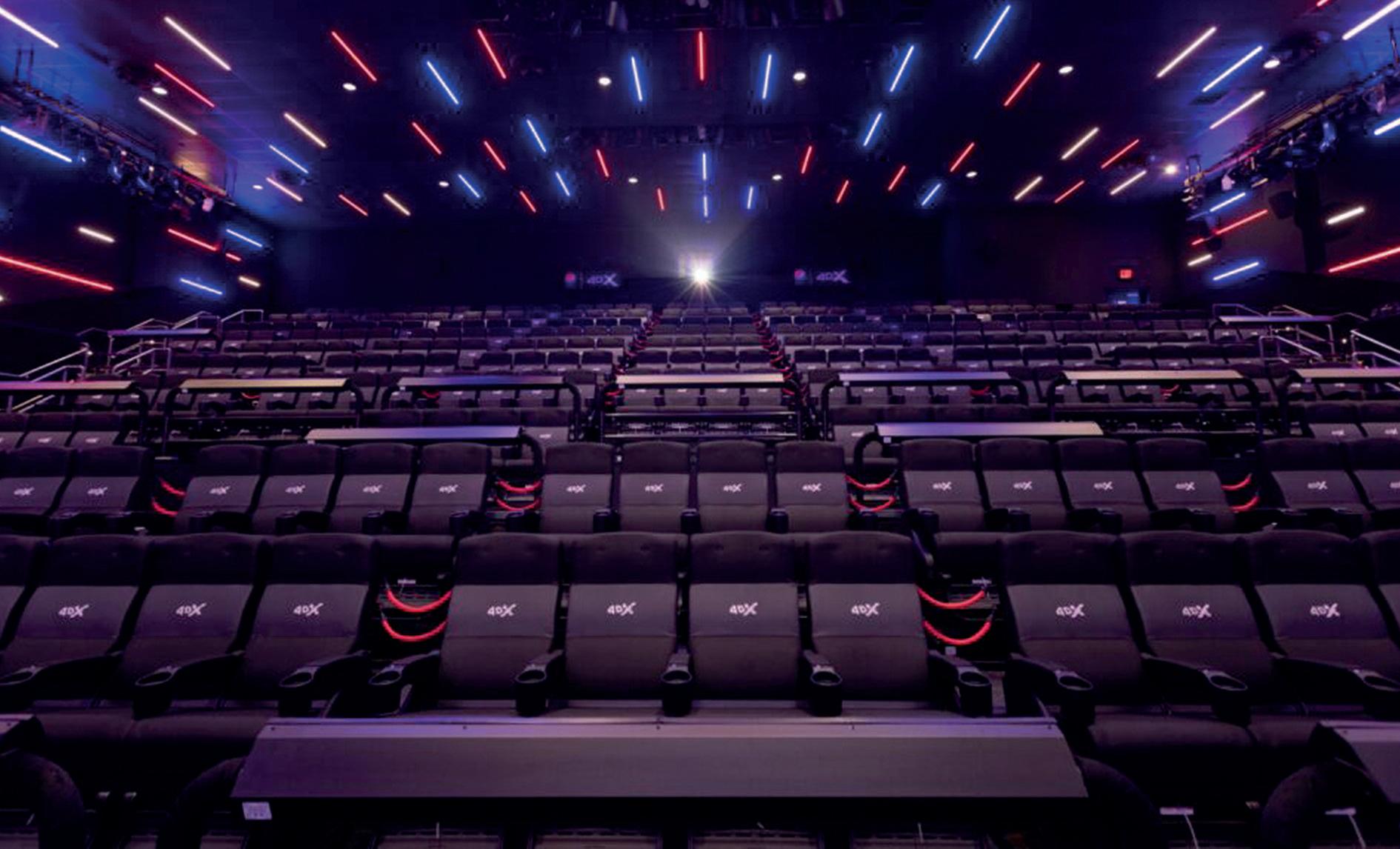
PPDS, the exclusive global provider of Philips Professional Displays and dedicated AV solutions, announced the installation of 568 remotely managed 4K Philips digital signage and videowall units in all Showcase Cinemas in North America, transforming the moviegoing experience and delivering lucrative new sales opportunities.
Founded in 1936 in Dedham, Massachusetts –and owned by National Amusements Inc, Showcase Cinemas is one of the world’s oldest and most recognized global theater chains, with 76 venues (operating almost 1,000 screens) spanning the US, UK, Brazil and Argentina.
Synonymous with comfort and quality, Showcase Cinemas – operating under a variety of brand names, including Cinema de Lux, SuperLux and Multiplex in Massachusetts, New York, Ohio and Rhode Island – offers a wide and ever-evolving choice of dining options, including full-service restaurants, bars and cafés, and traditional concession kiosks. Technology plays an important role in Showcase Cinemas’ connected digital approach, impacting almost every aspect of its business, beginning before moviegoers even set foot inside its establishments.
Part of a major refresh of all Showcase Cinemas in the US, the company turned to Atlanta-based PPDS partner, DEEL Media – a leading digital signage solutions specialist, with extensive experience in delivering turnkey solutions to movie theaters – tasking the company to replace its ageing and outdated display network to transform the visual experience for moviegoers. This included delivering additional and consistent communications across all locations, while creating new revenue opportunities.
Following deep-level discussions and site visits, 549 x Philips Signage D-Line 4K UHD digital displays (43”-75”) and 19 x Philips Videowall X-Line (49”-55”) displays were selected and installed in all Showcase Cinemas lobby areas, as well as along corridors leading up to each theater screen. This replaced the previous scatter gun approach to displays, switching to a single manufacturer, rather than using multiple brands across its network, for more consistent capabilities and experiences.
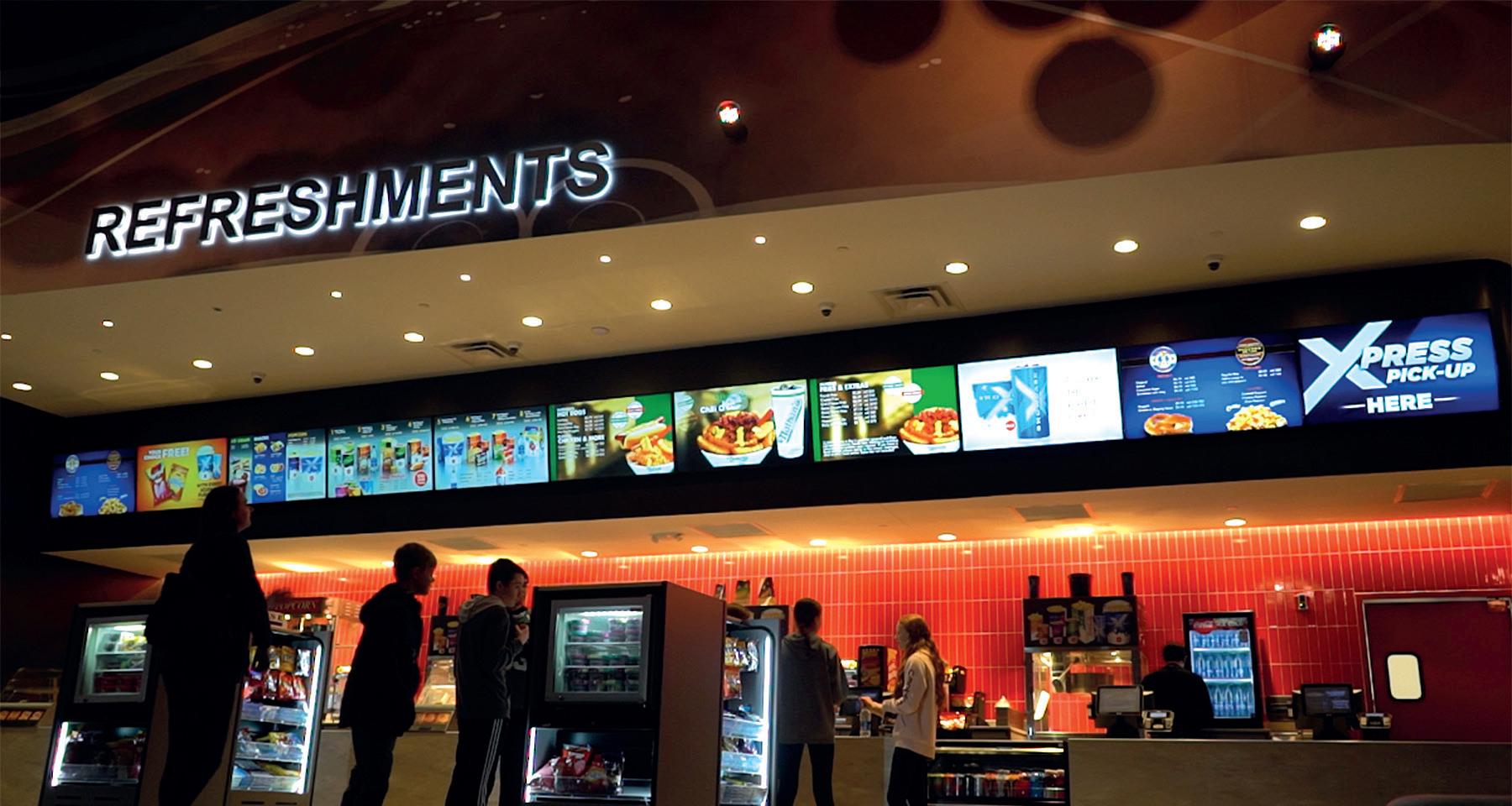
Philips X-Line and D-Line displays were selected, in part, due to their flexibility and versatility to conform to almost any environment, thanks to their powerful high impact 4K screen, ensuring picture-perfect performance in any lighting condition, including direct sunlight.
With PPDS’ ‘Open 2’ strategy – embracing complementary software platforms and hardware from other providers – displays were configured and tailored to suit each unique theater design and environment using DEEL Media’s proprietary ‘Carbon™’ content management system, providing extensive control, management and creation capabilities, managed either on-site or from a central location for the first time.
Designed for today and the future while transforming each space into a hive of digital activity, the Philips Signage D-Line and Videowall X-Line displays now provide a constant and varied feed of digital content to visitors. Removing all paper-based messaging, this includes box office information, trailers for current and ‘coming soon’ movies, and wayfinding, together with extensive branding and marketing opportunities that were not available with its previous system.
Continuing the feast of digital experiences, the centerpiece of each location – and a vital focus for additional revenues – are the main food concession kiosks, which feature an elevated and unmissable line of connected Philips Signage
D-Line displays, stretching the full width of the purchasing areas. Here, DEEL Media designed all the content to offer an ever-changing digital menu board, showcasing mouthwatering visuals, together with pricing, calories and deals on all available refreshments, such as hot dogs, nachos, drinks, popcorn, candy floss, and chocolates.
Despite a tight deadline, the project was completed across all movie theaters on time and has been hailed as a complete success, with all challenges overcome and ambitions met.
Bruce Wyrwitzke, Director of Sales NA at PPDS, said: “Our Philips digital signage and videowall solutions have a proud and proven track record in helping businesses to transform visitor experiences in a variety of markets and environments, culminating in increased profits. We’re proud to have supported DEEL Media, a PPDS Global Alliance Partner, in helping Showcase Cinemas achieve its ambitions for what has been a hugely important project.”
Vik Joshi, Assistant Vice President of Retail Technologies at Showcase Cinemas US, said: “At Showcase Cinemas, we offer an experience that separates us from other exhibitors. This project with DEEL Media and PPDS came about because our old signage system had become outdated and needed a refresh. We were very impressed with the quality and capabilities of the solution presented, and after an initial trial, we were happy to go ahead with the full refresh across all our US locations.”

With nearly 900 members in over 80 countries, Cinema Technology Community (CTC) is the world’s leading independent, not-for-profit trade organisation providing valuable educational resources to the global cinema industr y
With a highly engaged global community and a regular stream of content designed to help the industr y improve the movie-going experience for consumers, CTC is the go to place for cinema industr y executives
And what’s more, it’s completely free to join because, at CTC we believe that the industr y is stronger and better when we all learn and share together, so we’ve removed the biggest barrier THE
Join our global community today for FREE by visiting www.cinema-technology.com
With continued thanks to our sponsor s: Admit One, Christie Digital, Cinionic, Deluxe, DX, Ferco Seating, Harkness Screens, MAG Audio, QSC,
Box office grew by 28.6% in 2023, which was the first year for four years without any COVID closures. The global box office is 80% of where the market was against the average of 2017-2019 and can be expected to remain relatively flat in 2024 due to the impact of the strikes on film supply. Most markets are recovering steadily, if slower than exhibitors would like. There are some exceptions, such as South Korea where a combination of large ticket price rises and narrowing genres amongst film producers has depressed a successful market to the extent that the 2023 figure is still 45% behind that of 2019.
The global picture looks more positive in 2025 as studio content comes back to higher levels, with at least 10 major films pushed into 2025 from 2024 because of strike-related production delays. At the other end of the scale, 2023 box office in Bulgaria exceeded that of 2019, as it did in the major market of India, while the Netherlands is at 94% of the 2019 level and Finland is at 95%. Each country is following a different path to recovery, and while learnings can be transferable, the market structure, competitive environment, success of local language films and consumer shifts vary and alter the dynamics in play. However, it seems that markets can recover fully, and Omdia forecasts that nearly all markets will have recovered by 2025/26. A barrier to that could be people preferring to watch movies at home, but nearly everyone who regularly went to the cinema has come back at some point, even if they now go less frequently than before COVID. The habit needs to be re-formed. The most oft-cited reason for not going to the cinema is expense in a time of significantly raised living expenses. This primary reason also suggests that as this pressure eases in 2024/25 (assuming it does), people will return to the cinema once again.
Globally, the five major studios earned gross revenues of $17bn in cinemas worldwide in 2023, up from $16.1bn in 2022 but still down significantly from the $25bn minimum earned in 2017, 2018 and 2019 when Disney’s Marvel Universe was driving box office and China was a booming market for Hollywood. Those days seem to be over, and the disappointing returns from the Marvel franchise titles in 2023 may also spell an end of this era. For the first time in a quarter of a decade, the top 3 movies globally do not include a franchise but are original content with a variety of source material.
The reduction of studio dominance has been matched by the growth in revenue generated by local films. This applies especially to China, where local movies now take 84% of the market (both in 2022 and 2023), up significantly from pre-COVID norms, and driven by a marked increase in the popularity of domestic movies, which are now higher quality and reflect local culture. In addition, Hollywood has been frozen out of the market at times, for economic or cultural reasons.
Another relatively new market, Saudi Arabia, is also showing signs of local success, where 13% of releases were local language movies, and these achieved 36% of the box office. This is encouraging for the nascent Saudi production sector. Across Europe, a number of local films also shone during 2023, underlining a positive trend for domestic producers and distributors which may have started as tactical following COVID supply issues but could become longer-term. The quick bounce back by producers also indicates wider optimism in the theatrical market.
Variety and new ideas will drive the next decade of cinemagoing
The Top 3 in 2023 were Barbie (Toys IP/female-targeted), Super Mario (Gaming IP) and Oppenheimer (issue-led biography), none of which came out of an existing franchise, even if they might form the basis of new ones. Regarding Super Mario, Omdia has released two reports highlighting the increasingly successful transition of video games to movies, an area that used to be seen as a graveyard of ideas but is now spawning a range of successful projects on film and TV.
New movies based on toys are a distinct possibility for the next few years, building not only on Barbie, but also on the success underpinning the likes of Transformers and Dungeons and Dragons. Those latter titles came out of Hasbro, while Mattel (which is behind Barbie) is reportedly developing 45 different projects for theatrical titles, including Barney the Dinosaur, Hot Wheels and Uno. Mattel set up a film division, Mattel Films, in 2018. Hasbro bought eOne in 2019 but disposed of it in 2022 to Lionsgate and is now channelling its film properties through Hasbro Entertainment, in a marked change of strategy.
Other successes in 2023 suggest possible genres that could be exploited, not including staples like horror films that are already on the up: Taylor Swift (theatrical musical concert), Hunger Games (literary adaptations), Demon Slayer (anime/subculture), Mean Girls (musical comedy), and the Bob Marley: One Love (biography) are just some of the avenues that could drive the next few years. In fact, it is entirely plausible that all these genres and more will drive the market, as a wider variety of original content and source ideas come back to our cinema screens. The desire for people to see films reflecting their culture is a core part of cinema and it looks to be on the up. The differentiating factor between now and pre-COVID is that both Hollywood and local films were thriving up to 2019 whereas now Hollywood seems to have reached another plateau which requires a shift in the types of films the studios make. There is room for both strong local filmmaking and global movies but with a weak 2023 and the impact of the strikes to come in 2024, the job of the studios seems that much harder. While they need to focus on making theatrical films, not filling streaming pipelines, they worked out a way to adjust a decade ago when their dominance was under threat, and they will no doubt adjust and adapt again. It is in the interests of the cinema industry, and cinema audiences, that they do so.
Returning to franchises, in North America, 29 franchises took a lowly 54.7% of the box office earned by the Top 50 movies, significantly down on a high of 79.7% in 2021 but with a similar number of movies. This may spell the end of a period dominated and driven by the excitement generated by franchise films, from Marvel and DC to animation, Star Wars and Fast and Furious.
As the studios experienced a decade ago, film ideas have a shelf life if they are exploited frequently because audiences lose interest over time. The phenomenal success of the Marvel Cinematic Universe underlines both points: the Disney-owned brand drove box office to new heights but over-exposure (not just on the cinema screens) dilutes the impact and interest.
in North America, 29 franchises 54.7% of the box office earned by the Top 50 movies.
54.7% $17bn
The 2023 worldwide take of the 5 major studios in cinemas
& Movies Intelligence Service, which offers comprehensive data analysis on global film and cinema markets & technology to provide a holistic view of the industry.

In their 2024 Social Media Trends Report, SEMRUSH Social (an online visibility management and content marketing platform) pointed out that “natural”, user-generated content and “realness” are the name of the game when it comes to building trust with audiences. Even with content creators, being authentic is finally becoming more important and relevant than stardom or vanity metrics such as the number of followers — it’s the way to earn trust and gain engagement.
Yes, it might sound like a buzzword we’ve been hearing about for years, but we also know, from practice, that brands that leverage behind-the-scenes content, their employees as real ambassadors, and so on, are the ones reaping the rewards. To quote another study by McKinsey from 2021: 71% of consumers expect personalised interactions from brands, while companies that leverage personalisation see more return on their marketing investment (up to 40% for fast-growing companies). So all signs point, for years now, to creating more points of contact with your customers, genuinely. What does this mean for your cinema? I’ll be exploring easy, fun, and creative ways to include authentic communication and personalised marketing tactics in your cinema marketing — with insights from the many conversations I’ve had with cinema operators from DX’s community, who do it well.
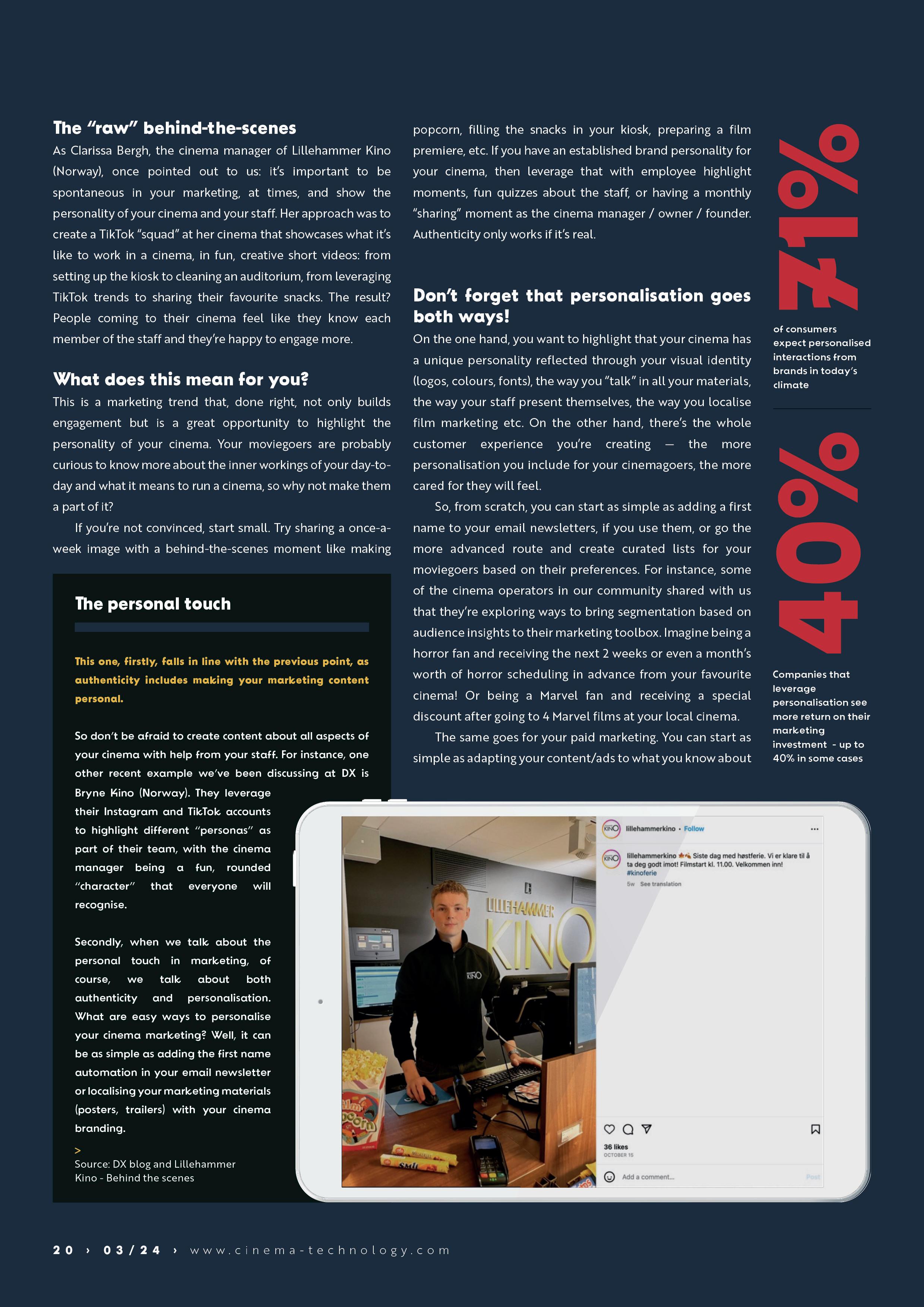



Whilst LED lighting is not new to the industry, GDC Technology introduced a system to take LED lighting capabilities to another level by introducing a more dynamic and exciting approach to the technology. In this article, we will take a look at the ‘DIVE™ Dynamic Lighting System’ and see how it is being used to enhance the movie-going experience at sites across the USA with leading exhibitor, B&B Theatres.
LED lighting is a type of lighting that uses light-emitting diodes (LEDs) as the source of light. These LEDs are semiconductor devices that emit light when an electric current passes through them, which is very different from traditional lighting methods. Advantages of LEDs is that they are more energy-efficient, durable, and long-lasting when compared to traditional
incandescent or fluorescent bulbs. LEDs can produce different colours and effects, making them suitable for various applications and environments, such as cinema. The most common type of LED used in the cinema is strip lightingflexible strips of LEDs that can be attached to any surface or held within a casing, to create a continuous line of light.
Whilst many cinemas already use LED lighting within their auditoriums, it is most commonly a static colour, or range of colours, that has fixed patterns or modes of operation. So, not ‘dynamic’. The team at GDC Technology developed an exciting new product to take LED lighting to another level with the DIVE™ Dynamic Lighting System – a patented programmable technology that offers ‘dynamic’ full RGB lighting in an almost limitless amount of modes and settings. It is a powerful and flexible LED control solution developed to program a themed single or multi-colour light show during pre-show entertainment creating an immersive experience like no other lighting technology in the market - it is not designed or intended to be programmed during feature films.
The DIVE Dynamic Lighting Control System powers up to 32 LED channels per unit and can be linked together for up to 512 controllable channels – various effects can be achieved thanks to being programmed with the DMX protocol - such as blinking, dimming or brightening, wall washes and lots more.
The technology is fully automated when paired with GDC media servers but can work with any brand media server in the market. The hardware is easy to install and maintain and is fully customisable to synchronise with pre-show content.
The DIVE Dynamic Lighting Control System is capable of automation over Ethernet with virtually any cinema media server or automation device and allows a custom light show to match the auditorium configuration, and is fully programmable for any future light shows.
DMX stands for Digital Multiplex, and is a protocol used to control devices such as lights or fog machines. DMX consists of up to 512 individual channels, which are known as a ‘universe’. Each channel can control a different parameter of the light, such as colour, rotation, or strobe. DMX-compatible products will have different modes of operation, such as soundactive mode, 4-channel mode, 7-channel mode, etc. Using this protocol means that a cinema can connect multiple units for more channels – with up to 32 separate channels per unit.
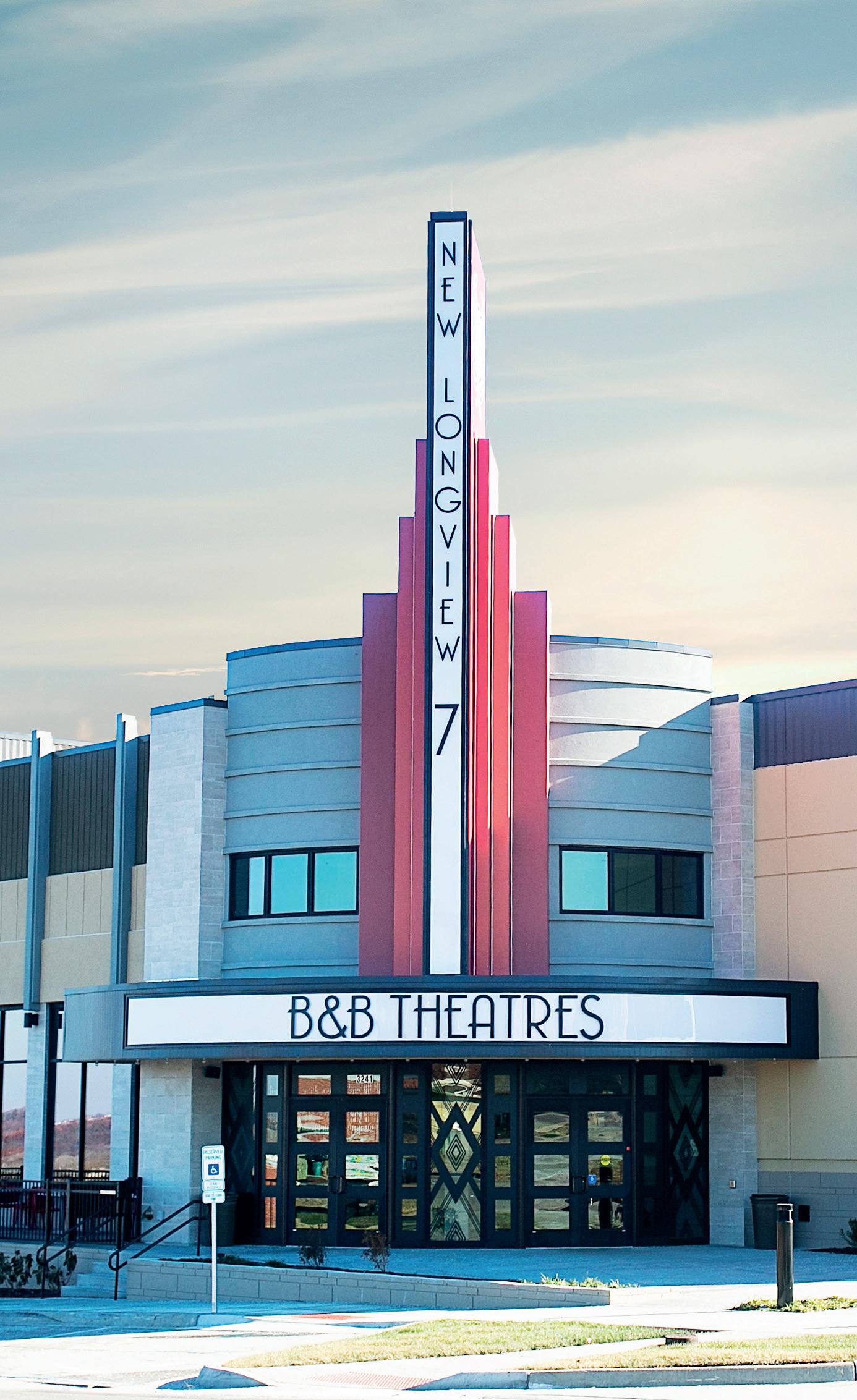
The technology comes into life when configured to be used with pre-show advertising. The pre-show really can become a ‘show’ with the DIVE™ Dynamic Lighting System. The use of specific and programmable lighting can elevate the impact of a brand using the cinema for advertising. Imagine a specific brand is orange, green, or blue and the whole auditorium can be lit up along the same colour scheme at the same time the advert is playing – this is exactly what can happen with the DIVE™ Dynamic Lighting System!
It can also be used to enhance and mirror the colours and effects of the on-screen content – Cinemas and advertisers can match the colour sequencing to the preshow soundtrack to fully immerse the audience.
Application Idea: Technology Enhancement
Cinemas that have invested in premium format technology can use the DIVE™ Dynamic Lighting System to enhance and ‘show’ customers how and where the technology works in the auditorium; For example, an immersive audio system could have LEDs around all of the speakers in the room to highlight where in the room the speakers are placed,– it can allow the cinema-goer to ‘see’ as well as ‘hear’ where the immersive audio, such as DTS:X is coming from and further excite and enhance the experience.
LEDs could be used around the screen to amplify the message of a premium screen size or technology – the options are endless!



The DIVE™ Dynamic Lighting System is amazingly dynamic and has a wide range of applications for pre-show and promotional use, but it can also be used for corporate branding needs – this could be for the cinema’s own branding and colours and for the use of private hire and corporate rental use when third party brands and business use the cinema for conferencing and alternative use.
B&B Theatres Operating Company, Inc. or simply B&B Theatres (is a family-owned and operated American movie theatre chain based in Liberty, Missouri. Founded in 1924, B&B is the fifth-largest theatre chain in the United States, operating 500+ screens at 56 locations in Florida, Georgia, Iowa, Kansas, Minnesota, Missouri, Mississippi, North Carolina, Oklahoma, South Carolia, Texas, Virginia, Nebraska and Washington.
1 Entertain the audience with an immersive light show during the pre-show entertainment.
2 Highlight the company’s guest policies and commitment to providing the best moviegoing experience in the local communities they serve.
3 Enhance the pre-show onscreen advertising platform to increase recall of local and national advertisers.
The actions taken to solve these challenges were:
Researched lighting systems designed to entertain, finding there is only one system available that is designed to entertain audiences during the pre-show entertainment.
Installed GDC’s DIVE Dynamic Lighting System in the Grand Screen and ScreenX auditoriums to provide their guests with a dazzling light show during the pre-show. Given the DIVE system is easily programmed in DMX language, the B&B marketing department programs light shows for its onscreen promotional programs and upcoming movies. The programming is synced with either the audio or video. For example, The DIVE lighting was programmed in all blue to promote Avatar: The Way of Water.

 Toni Purvis, Director, CTC
Toni Purvis, Director, CTC
In November 2023, the industry was abuzz with the news of Barco’s full acquisition of Cinionic. This strategic move involved the seamless integration of Cinionic’s sales, marketing, and service activities into Barco’s Cinema business unit, consolidating everything under one roof. It was announced that Gerwin Damberg would continue to lead the business unit, with Wim Buyens continuing to support a smooth transition of the cinema business.
We had the opportunity to speak with Gerwin Damberg to unravel the implications of this acquisition and gain insights into the short and long-term future of Barco.
But importantly, it was an opportunity to get to know Gerwin a bit better.
Gerwin isn’t a stranger to the broadcast and cinema business, having started his journey a good two decades ago. His time at university saw him as editor-in-chief for a student TV show which led him down the garden path of the technology surrounding broadcast.
‘…we were the first HD channel that broadcast television in Germany before all the big major stations were able to jump on it.’
Whilst still studying at University in Germany, Gerwin joined a startup company on the west coast of Canada which eventually led to him relocating. The startup invented a new
type of display technology for post-production, cinema, and ultimately television.
‘So what’s known as mini LED and local dimming came out of this cringy physics basement lab of the University of British Colombia’.
That startup was sold relatively quickly to Dolby Laboratories who at that time were looking to expand from a strong foothold in audio into video technology. This was where Gerwin’s interest in projection developed. After a few years at Dolby, he started a new company and earned a PhD in Computer Science (Graphics), which further deepened Gerwin’s technical knowledge.
Gerwin has been with Barco for the last six years, in various roles, and is currently serving as CTO of the group. With Cinionic now being fully under the Barco banner Gerwin has ‘full focus on cinema now’.
So now that Cinionic and Barco are now one unit, what does that mean operationally?
The two teams worked very closely together before the merger and they were already colleagues; but by melting those entities together, they have created what is being described as a ‘powerhouse of a cinema team’. Gerwin explains that the full experience for the cinema and the audience needs to be perfect, and that integration at the top level is the key to achieving that.
‘It doesn’t matter if a single piece of the installation is good, everything has to be good from the content delivery, to the sound, to the ceiling.’
To achieve this, the R&D, product and factory teams within Barco will now work even more closely with the customerfacing part of the pipeline. With Barco’s focus on replacing lamp-based projectors with laser solutions, there is a need to set up cinema-as-a-service and introduce finance deals to make the barrier of entry lower for customers who wish to convert to newer technology and ultimately provide their audiences with a better experience.
As such ‘…it was just a logical step to put the teams together and make sure that with this next generation of offerings we are, also on the product side, much more integrated.’
2024 has started off incredibly brightly for Barco with the
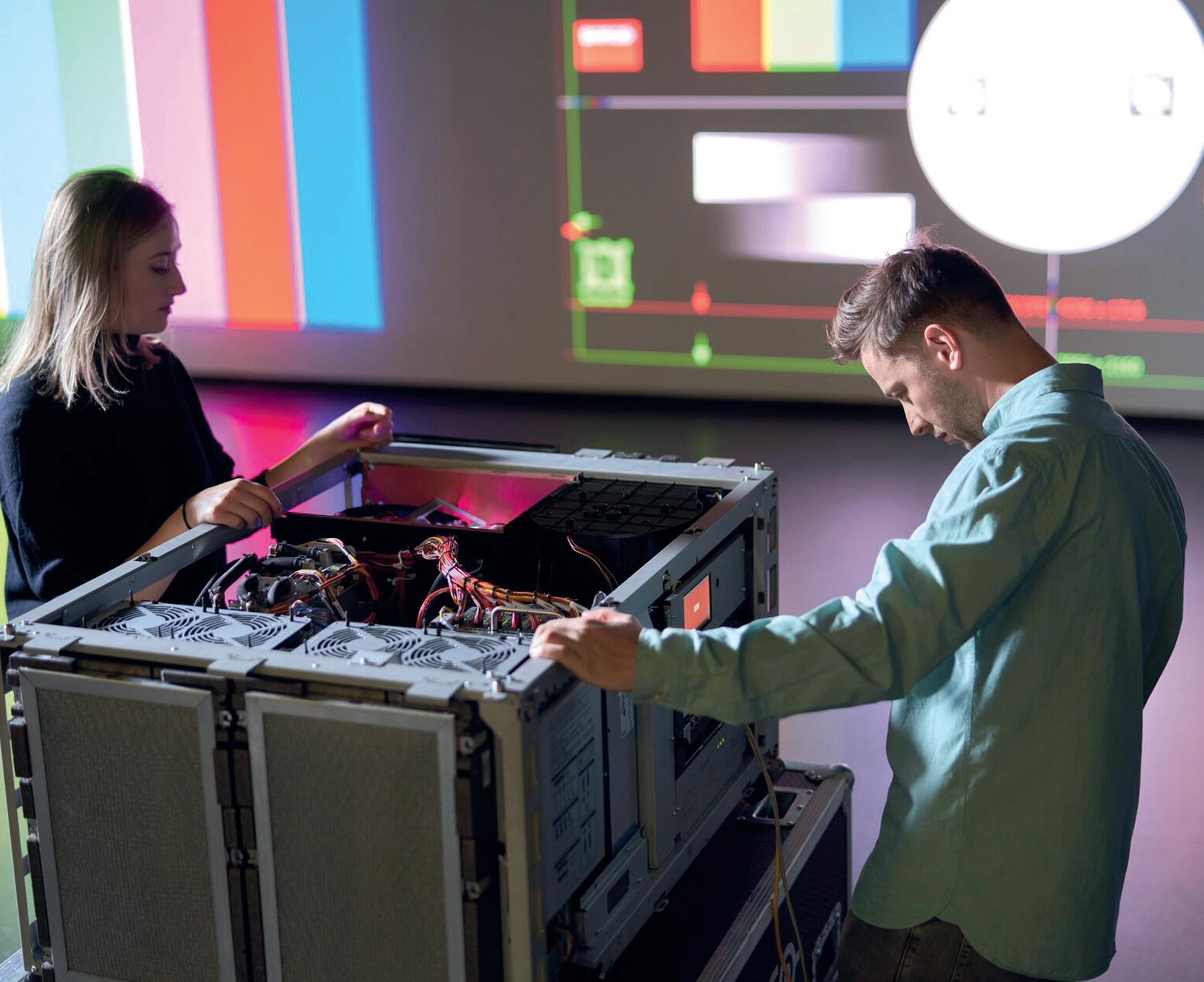
“ We’ve clearly seen that the audience generally prefers the consistency of laser the colourfulness of laser, even the small gains of contrast, over lamp projectors. “
company earning its first Academy Award, in the scientific & technical category, which Gerwin describes positively as ‘the geek show of the Oscars’.
Barco has been recognized for the design and development of the Barco RGB Laser projector, and for having brought laser technology to the mainstream.
‘Three of our colleagues and Barco have been honoured for the Barco laser projection system, and that was really the foundation to get us to today, where we’ve converted north of 30,000 screens to laser…’
Gerwin explains that this is the trajectory Barco wishes to continue upon, rolling laser technology broadly and ultimately elevating the overall cinema experience for all.
The 30,000 screens that Barco has converted to laser have been a mixture of new laser upgrades and retrofits. Gerwin explains that the retrofit business has seen a lot of traction. It
has allowed customers to enjoy the benefits of lasers whilst using an older projector which still has a few years of life in it, something that can provide great value ahead of making the move to a new RGB laser projector, for example.
When looking at existing estates, there are still many firstgeneration digital projectors out there, which are now approximately 15 years old. Despite the impressive longevity of these products, Gerwin explains that there is a need to upgrade to guarantee a cleaner and more repeatable experience. Barco’s movie-goer testing has produced results that support this opinion.
‘We’ve clearly seen that the audience generally prefers the consistency of laser, the colourfulness of laser, even the small increases in gains of contrast, over lamp projectors.’
But as Gerwin explains, the benefits are not just limited to what is seen on the screen. ‘The benefits of moving to laser technology is just enormous in terms of maintenance, serviceability, lifetime and overall cost of ownership.’
Exhibition has been hit hard in what has been a
challenging few years, and that is why Barco has put cinemaas-a-service and financing models in place. With these options available, Gerwin sees a large proportion of the market moving over to laser within the next 3-5 years and having a fully integrated solution is appealing for a frictionless experience.
‘We see that customers don’t pick us necessarily for the better box. They pick us because they get the full solution from us.’
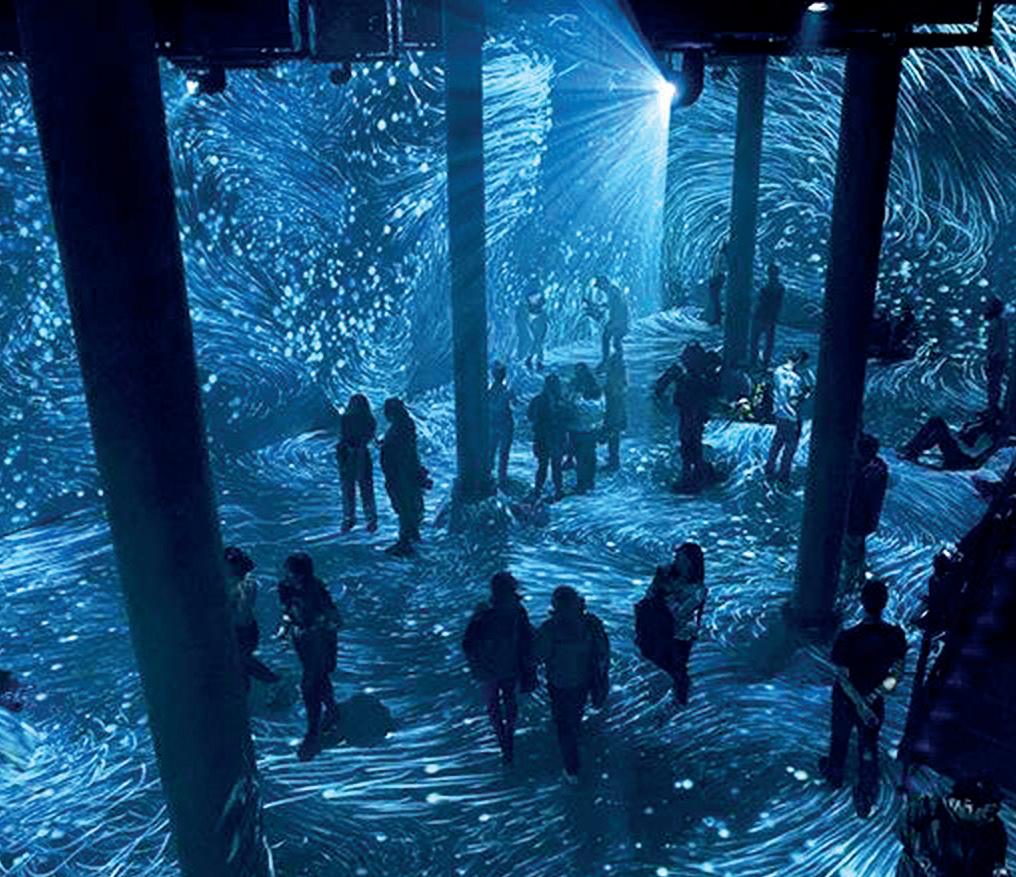
I asked Gerwin what he would like to see in his local movie theatre in the future, and I encouraged the bizarre.
‘I think there’s still this whole Holy Grail of holography, we just don’t have a clue how to get there. I think in lobby experience and connecting with a story that you’re about to see on the big screen in a different way, that will ultimately be something that might work’.
The challenges faced to create a full 360 environment are not insignificant. We have been trained to tell and receive a story in a certain format. We are very familiar with being told what to focus on when it comes to standard 2D and 3D movie and broadcast content. In a 360 environment, that ability to direct focus would be very difficult to control and calls for a different approach to storytelling. That said, studios have experimented with this. Other technologies are coming out from the likes of Apple and Meta which are heading down this road.
I think it would be wise to keep an eye on Barco in the coming years. Given their innovative nature, and with enthusiastic and highly knowledgeable people at the helm, I wouldn’t be surprised if we see more exciting products in the not-too-distant future.


A look at PaperAirPlane Media, a US start-up founded in the middle of a global pandemic that’s revolutionising the way digital marketing assets are managed and delivered across North America.
Richard Mitchell, President, CTCThe world looked a different place in early 2020 for former senior Lionsgate executives Mike Polydoros and Will Preuss. With two stellar careers in theatrical marketing behind them, the duo found themselves in the right place at the right time to found PaperAirPlane Media, a company designed to help studios distribute digital marketing assets such as posters, trailers, web banners and videos to exhibitors in a more timely and cost efficient manner.
“In the movie industry there’s an agency for just about everything, but the one area that we felt lacked support was the in-theatre space and the distribution of marketing assets from studios and content providers to exhibition,” explains Will Preuss, President of PaperAirPlane Media. “We experienced it first hand and knew some of the challenges. We identified the requirement for a centralised hub where exhibitors could find assets from major studios, independent studios, event cinema partners and wider partners from film formats through to food and beverage, pretty much anyone with marketing materials looking to reach the consumer.”

Imagine trying to start a business, in the middle of the pandemic and with cinemas shuttered for an unknown length of time. You’d think it an almost impossible backdrop with which to gain traction, especially for a start-up in the conceptual planning stage, however it turned out to be quite the opposite. From hectic schedules, executives on both sides of the industry suddenly found their diaries surprisingly clear but with a pressing agenda to streamline costs and drive efficiencies which played perfectly in to the vision that Mike and Will had for PaperAirPlane Media giving them an ideal opportunity to present the vision albeit via conference call and to a wide audience from studios and major exhibitors through to small independent operators.
The first steps for Mike and Will were to create the cloud-based platform ‘Hangar’ that would serve both studios and exhibition. The space the pandemic created allowed the team to work with different exhibitors (from large multiplex chains through to small independents) to test the service and to provide feedback allowing exhibitors to shape the service that was ostensibly aimed at them. With a single login to the secure cloud-based service, users are able to find assets for virtually any release opening in their cinemas and download them. Whilst these assets are locked and uneditable or customisable, they do at least create a pathway for exhibitors to reach out to studios should they wish to do adaptations.
“The studios really liked the concept because for the first time, we could provide visibility to trends within the industry in terms of the assets being downloaded and the types of content that exhibition was looking for because of the unique user


management system that sits around the service. This allowed us to tell that story to the studios with real data enabling them to make more informed decisions about the types of content required. Since we launched The Hangar, we’ve seen a tremendous growth in terms of the amount of assets that are being provided to exhibition to support a movie, so that’s been really satisfying because it feels as though we’ve been able to support the marketplace with not just what exhibition needs but also what distribution is looking for as well,” explains Will.
That data has seen not just an increase in the number of marketing assets but also in the targeting of assets. Relatively quickly, the team noticed a trend that digital and specifically video assets for social media were the most downloaded pieces of content whether a tentpole or independent release. That feedback has enabled the team to focus studios towards the assets required by exhibitors and also to encourage the studios to make those assets created by the studios, for their own use available to exhibition to help amplify and co-ordinate the marketing message.
The Hangar has also had the positive effect of more assets being downloaded and used than perhaps might have been utilised previously.

Will shares that, “for exhibitors to have the visibility of all the assets for a campaign in one place has proven really helpful. We’ve seen a lot of exhibitors land at The Hangar looking for one asset and downloading more, a bit like a trip to the supermarket for milk and coming out with a basket full of items. It’s now really rare for exhibitors to log in, download one asset and log out and often, we find The Hangar has enabled users to find assets they didn’t even know existed.”
“...tremendous growth in terms of the assets that are being provided to exhibition...”
Something that shines through is the great pride the team has in democratising the access of marketing assets to small independent cinemas. Typically the small cinema operators have proven very difficult for studios to reach when it comes to marketing assets. Whilst these exhibitors might be members of the Independent Cinema Alliance (ICA), they’re still often challenging to reach because of the bandwidth restrictions the studios have. As the independent cinemas have started using The Hangar, they’ve been able to obtain the same level of access to marketing assets as the major US operators. For the studios, that reach across the industry to deliver things like the correct movie synopsis, or poster file is advantageous. Prior to The Hangar, the smaller exhibitors may have had to pull assets from Google searches or IMDB which of course has the associated risk of inaccuracies for example the use of posters from other territories. Now the studios have the confidence that their movies are being marketed across the industry as they intend.
And The Hangar hasn’t just help studios but formed a vital link in ensuring the US-based National Cinema Day sponsored by NATO (in both 2022 and 2023) was a success by identifying the type of assets exhibitors would need to talk about the initiative, the availability of those assets and the strategy behind the campaign. The service also allowed NATO to reach further in to the independent sector enabling National

Cinema Day to be an enormous success in each of the past two years when the entire sector aligned to drive cinema-going.
The Hangar platform is funded exclusively by studios and content providers who pay for each “campaign” (which could be a movie release) with an unlimited amount of assets assignable to the campaign. For exhibition the service is completely free. In essence the model is very similar to physical marketing assets where the studio creates the poster or standee, they pay to ship it and then the agreement is that the exhibitor puts it to use in their lobby or surrounds. In this instance, the studio provides the digital assets for use across the exhibitors digital footprint. The Hangar was deliberately placed at a low enough price point to become an industry utility whilst allowing studios to participate because the PaperAirPlane Media team realised that the real value to The Hangar as an industry tool is in having every part of the industry utilising the service.

“We have a lot of experience of doing group sales and being in the trenches...”
The Hangar is just one element of PaperAirPlane Media’s vision to support the industry. With a growing team of experienced industry professionals that also includes former AMC Theaters executive Meggie Isom, Lionsgate executive Amanda Rufener along with Barbara Dretzke, Laura Beth Winchester and Nick Polydoros, the business is also able to support broader in-theatre marketing. If a title doesn’t have a specific in-theatre team to help distribute content including trailers or to support exhibitor media buys, the PaperAirPlane team is able to be that resource utilising their years of experience to drive success.
Group Sales, where a cinema is privately rented for a screening has always been disparate and difficult to manage given that enquiries can originate either at a studio or exhibition level. The team have sought to simplify this process by creating a level of transparency to the sale through ‘The Tower’.
The recently developed Tower enables group sales enquiries (typically a buy-out of the whole auditorium) to reach the right exhibitors removing laborious email activity and spreadsheets from the workflow ensuring that all leads are tracked and ideally converted. Specific APIs enable The Tower to connect to the studio’s web site and indeed that of the exhibitor to collate, organise and distribute leads efficiently. Such a tool is an enormous advantage particularly for studios in enabling them to manage what could be hundreds, perhaps even thousands of leads in an efficient manner whilst identifying the timeline and potential box office revenue from those potential sales.
“We have a lot of experience of doing group sales, being in the trenches and knowing how challenging that is and the pain points involved, the Tower really does help. Often, neither the studio or exhibitor has a dedicated member of staff focused on group sales, so driving those efficiencies can be enormously important. It’s not to say there aren’t still challenges but we hope that the tool does make it easier for those having to manage these enquiries on a daily basis,” Will concludes.
The Hangar is such a revolution and success story that the team has an eye on expanding their footprint internationally outside of North America where many of the original challenges The Hangar resolved, still remain. Of course, such a move comes with many complexities such as localisation but a staged and methodical approach will allow the team to avoid some of the potential pitfalls that exist.
In-theatre marketing has changed. Long gone are the days where the studio was responsible for delivering the marketing message for a movie. Now, exhibitors need to work to drive audiences by addressing their audiences directly. That large-scale investment that exhibitors have made in seats, projection, screens and sound are all designed to create a compelling movie-going experience but content is still king and PaperAirPlane Media and their services are playing their part in ensuring the sustainable recovery of the industry after the pandemic by reaching movie-goers with aligned campaigns. Hopefully coming to a territory near you soon!

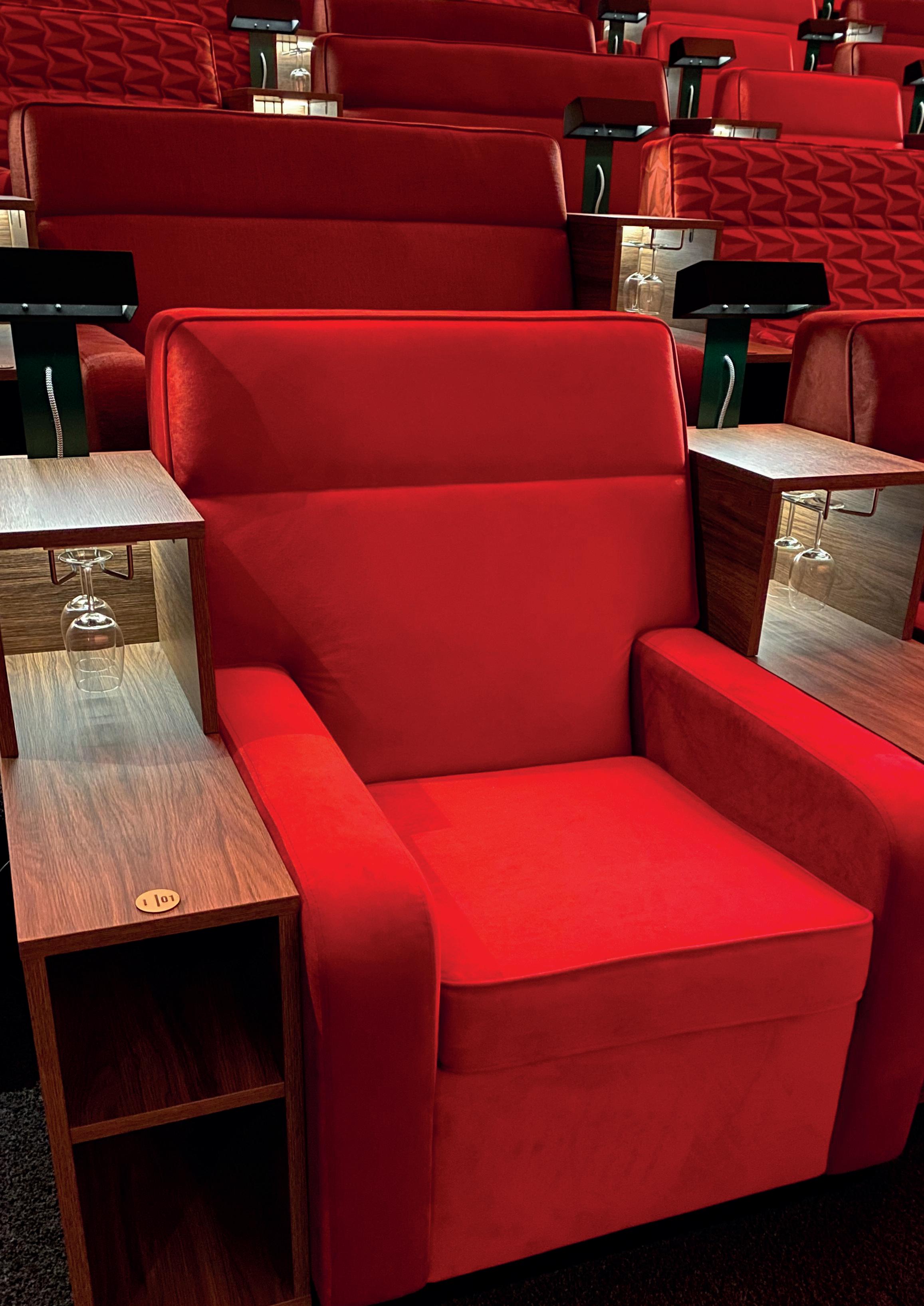
Everything is a matter of perspective especially when it comes to cinema seats, sightlines and style. But what matters most in a modern cinema environment? Where do we start a project and how prepared are we to invest in long-lasting seats? Do you know how much degradation can happen to a seat over time with thousands of uses each year? Comfort, space, price, return of investment? What are the key aspects to finding a good balance? So many questions with usually only basic guidance provided, so let’s look at the planning a cinema operator should do to ensure they improve the cinema experience from the ground upwards.
If you’re fortunate enough to be building a new cinema it’s very different from a refurbishment which may have many unforeseen design and construction challenges. Any refurbishment starts with the planning from the outside to inside and the limitations of the room. The complexity of a renovation can be huge as it will be for any equipment being installed inside a pre-existing auditorium. Don’t underestimate the level of complexity that may exist, from new fire regulations to legal limits and even the length of time it may take to complete the project.
Of course, a new site or auditorium should always be planned from its concept and needs inside first and foremost. If you start structuring the cinema from outside there is a risk that you may dramatically limit the choices and potential concepts available.

...or can you focus on developing a proper plan that might incorporate acoustic improvements and sightline optimisation, perhaps even staging upgrades? New seats, new staging ,new carpets, new sound? Here we are with the first considerations and compromises. A proper timeline is the most important limitation after financial constraints. In the past few years (especially in Europe) the labour cost of renovation has increased significantly. At the same time, the huge demand and cost increases in textiles, foam, wood and every part of a seat, has resulted in longer lead times which of course can affect the cost of the project. Ideally a project should start with a minimum of 12-16 weeks window in order to correctly select the improvements required. If as an exhibitor you’re targeting a specific movie to be ready by, start from the release date of that movie and create a six month window to design, specify, order and install. A longer window will avoid a rush to the finish line with the requirement for additional labour costs.
WHILST MOST ARCHITECTS SHOULD HAVE A WIDE EXPERIENCE...
...not all of them have worked in the cinema space. Finding an experienced cinema architect with a good foundation in cinema seating design and room dimensioning will make an enormous difference but of course, it comes at a cost. If that’s the route you’re going down, make sure that the architects can indeed provide you with what you need by visiting some of the auditoriums they’ve designed. If budgets are limited and the design needs to be handled in-house, it’s important to identifying areas where knowledge-gaps exist and to try and find the information required to make informed decisions. If you are limited in budget or simply need to exchange the seats, still consider if you are really aiming correctly. When you reach out to your customers to validate your ideas, do you stick
with their known favourites in terms of comfort and style or do you want to do something different? One thing the pandemic has taught us is that consumer behaviours are evolving quickly and as such many loyal movie-goers are almost like new customers. Those that haven’t visited your cinema in a while may want to be (pleasantly) surprised by a new design, long-standing customers might not like surprises. A good design can be reached with or without external help, but knowledge and experience usually saves a lot of time.
DO YOU KNOW THE PREFERENCES OF YOUR CUSTOMERS IN TERMS OF COMFORT, DESIGN OR ROBUSTNESS?
A lot of older customers prefer a warm textile, while the boomer generation prefer cool-looking faux leather seats. Gen-Z movie goers are most likely to appreciate vegan materials, so don’t mention real leather, it can start a big storm. Of course the choices you make need to encompass design but also longevity and then acoustic elements.
Taking your time and making rational and substantive decisions over style will serve you well in the long term. The Martindale test (an abrasion test for fabrics) is a key indicator towards robustness, the higher the value the better. But this is just one parameter that needs to be considered alongside flame retardance, cleanability and even environmental conditions. The choice you make should be a good compromise between quality, price, style but also encompass the aspects that not many care about.
CAN YOU AFFORD TO LOOK AT SUSTAINABLE OPTIONS AND DELIVERIES IN YOUR TERRITORY OR ARE ‘RETURN ON INVESTMENT’ THE MAGIC WORDS?
Is a sustainably sourced environmentally friendly product produced locally an imperative? Locally produced seats may require compromises in style and concept but they carry a lower carbon footprint. Perhaps this doesn’t matter to you but it might to your customers. If you think it might matter, asking your customers perhaps even via social media might help direct your pathway forward. Seating sourced from further away may be cheaper but cost more to ship with longer lead times. Of course, then there is the issue of local support to keep those seats functioning. Whatever you decide, one way or the other there is a balance of cost and time, as well as long lasting good local service.
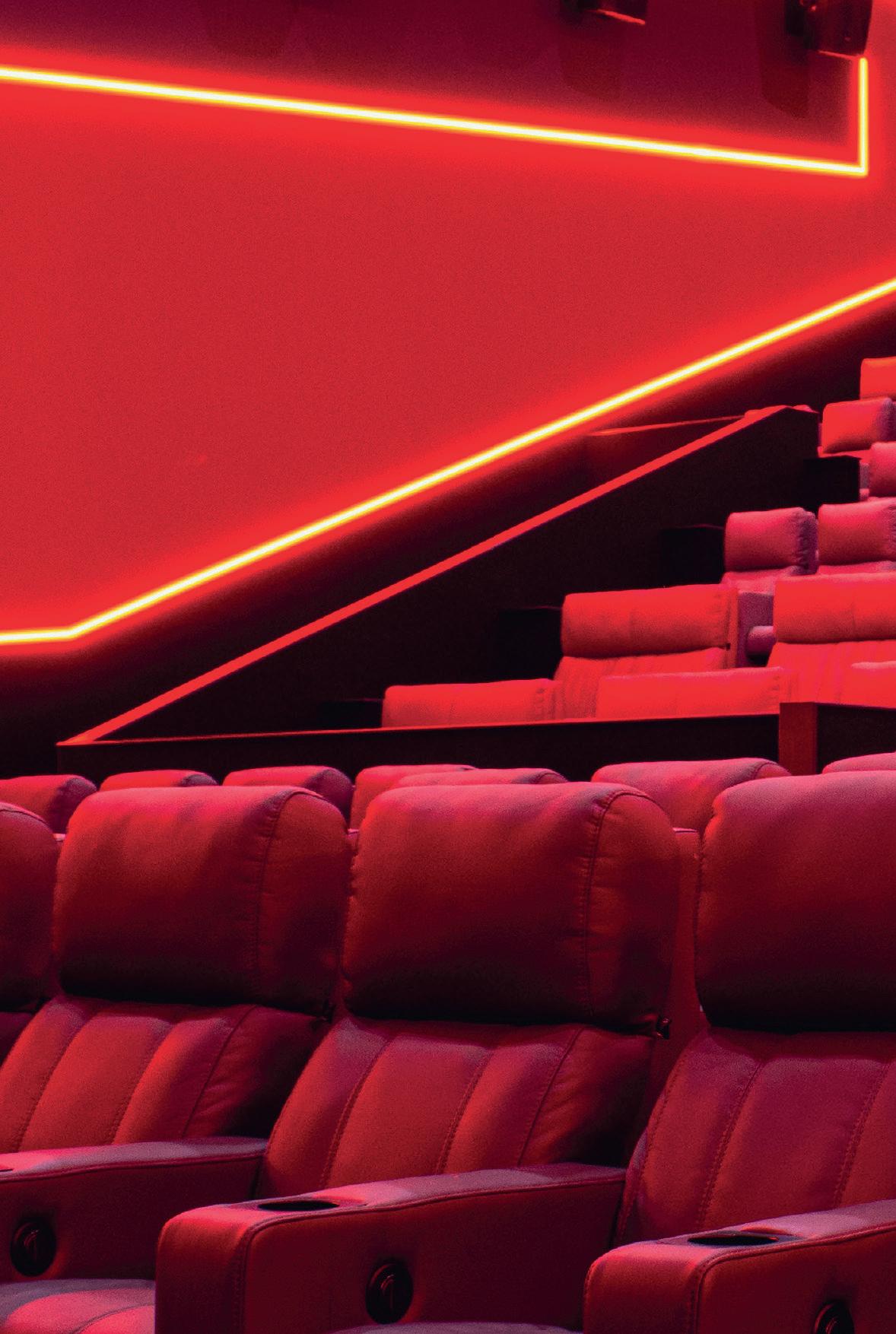


Why so late in the game? Because it’s the most over and underrated topic for seating concepts. Why? Because in my humble experience - that’s why you ask real experts for help with your specific cinema. Seating sightlines should always be great, but nearly always there is a compromise to ensure seat count is at a specific level. You can plan and align concepts perhaps even consider doing things that might not be advisable but it’s worth understanding the sightlines and how these are affected, not just for the standard adult movie-goer but for a small child or someone significantly taller. Of course, if you’re moving towards recliners, sofas or dine-in options, sightlines will need to be considered more deeply. Having the best seats installed won´t matter if you’re customers can’t see all of the picture or lack desired privacy due to space compromises. In addition, the placement and size of port windows can limit the final height of the back row of the seating area. And with lasers projectors (although any newly installed projectors), there is a requirement to preserve the hazard zone which of course will have an impact on the volume and position of seating.
This current buzz word is actually a fairly old trick. If the budget or design constraints don’t allow for changes in the riser structure, on-riser designs can help to make meaningful changes to seating. On-riser designs encompass cutting out a part of the seat and placing a more spaced seat, sofa or recliner on one step and skipping each second step. It does mean a loss of one row for each seating row as a two for one concept. In addition, you’re likely to need to add a safety barrier to prevent people from falling. It is a compromise on the aesthetics of the auditorium but it can be a nice design option. Another issue you may encounter is changes in the seat height and the affect that has on the sightlines if you don’t follow the typical step and view pattern. It usually works only in full auditorium changes and front rows, where sightlines are ok.
If you want to use on-riser recliners, you may still encounter difficulties with power and cabling issues. You may also find space is limited for fitting the typical seat mechanics. Of course this design option could save time and money in construction but will reduce overall seating capacity. Using non-reclining seats as an on-riser solution, such as sofas or arm chairs is a little bit easier, but it’s not a new concept and is still a compromise.
Whatever you think about seat design and the choice of seat, it comes down to a lot of compromises you have to make whilst remaining focused on the concept and goal you’re looking to achieve. Whenever I see requests for auditorium designs be that concert halls, soccer stadiums, theaters, museums, entertainment parks, churches, schools or cinemas, most people underestimate the challenge of the choices that need to be made. Most people go to a trade show with the intention at looking for new seats and are often swayed by nice designs or improved comfort and think they have all the answers without perhaps considering everything and this can end up with a less than desirable long term outcome.
Premium Large Format (PLF) experiences have become an important part of the makeup of the cinema exhibition sector. The big screen, the colour, and details, the immersive sound that you feel – it’s an experience that audiences will leave the house for. It’s therefore no surprise that three leading cinema technology providers came together to engineer a system that surpasses anything else in the market today.

INITY was established in 2016 with a strong commitment to advancing film technology and promoting deep integration and continuous innovation in the cinema industry. And in August 2019, CINITY introduced an advanced file format for Premium Large Format (PLF) cinemas that integrates seven features that are foundational to the moviegoing experience: 4K resolution, 3D, high brightness, high frame rate (HFR), high dynamic range (HDR), wide colour gamut (WCG), and immersive sound. Each feature pushes the boundaries of the cinematic experience and brings a unique sense of realism to the screen. Here’s how each contributes to the CINITY experience:

4K resolution: With DCI 4K (4096 x 2160) resolution, audiences experience clearer, sharper images.
3D: The system envelopes audiences in a bright 3D experience with 20ftL.
2D: All 2D movies get seen in a spectacular never-seen-before brightness of 35ftL.
High frame rate: Smooth, fluid on-screen action with frame rates up to 120 frames per second in 4K resolution.
High dynamic range: See the details in the highlights and shadows of an image.
Wide color gamut: Vivid colors with greater than 96.5% ITU.
BT.2020 coverage.
Immersive sound: For a complete, immersive soundscape.
The CINITY name is derived from cinema and infinity, which combine to create the ultimate movie experience. Like other PLFs, the idea is that it will provide the audience with the best experience for a Director’s work.
To achieve the step change, it took the participation of leading cinema technology providers – the China CINITY team, GDC, and Christie as well as– and collaboration with some of the world’s most renowned filmmakers. It took, four years to engineer a cost-effective system that provides a viewing experience that claims to surpass anything available; an experience that allows for the brightest images, three times higher contrast, up to 5 times the normal frame rate, with an expanded colour gamut that has 34% more colour than traditional cinema presentations, while also being capable of screening 3D titles on the largest possible screens. The CINITY Cinema System has earned global recognition: it won the Technical Achievement Award at CineEurope 2022 and was used to screen scenes of James Cameron’s epic sequel “Avatar: The Way of Water” in 2D and 3D. During that presentation at CineEurope 2022, Cameron noted that every shot of Avatar 2 “was designed for the biggest screen and highest resolution possible,” as the film pushes the boundaries of cinematic storytelling. Exactly what the CINITY Cinema System is designed to do.
The CINITY Cinema System promises to deliver a moviegoing experience unlike any other, enabling filmmakers to tell their stories, realise their vision, and take audiences into previously


unseen worlds. Part of this system includes Christie RGB pure laser projection.
Christie worked closely with Taiwanese filmmaker and threetime Academy Award-winner Ang Lee — who has directed many blockbusters including “Life of Pi” “Hulk”, and “Crouching Tiger, Hidden Dragon” — to support his vision for a pioneering largeformat projector that could showcase “Gemini Man” in 3D, 4K resolution, and at a high-speed frame rate of 120 fps. The result was the CP4450-RGB pure laser cinema projector.
The evolution of Christie’s RGB illumination technology was at the heart of bringing Lee’s vision of a large-format projector to fruition. The first generation of RGB pure laser projectors weren’t much more efficient than xenon due to multiple large laser devices that had to be coupled and inefficient cooling. And the projectors themselves weren’t budget-friendly, typically costing



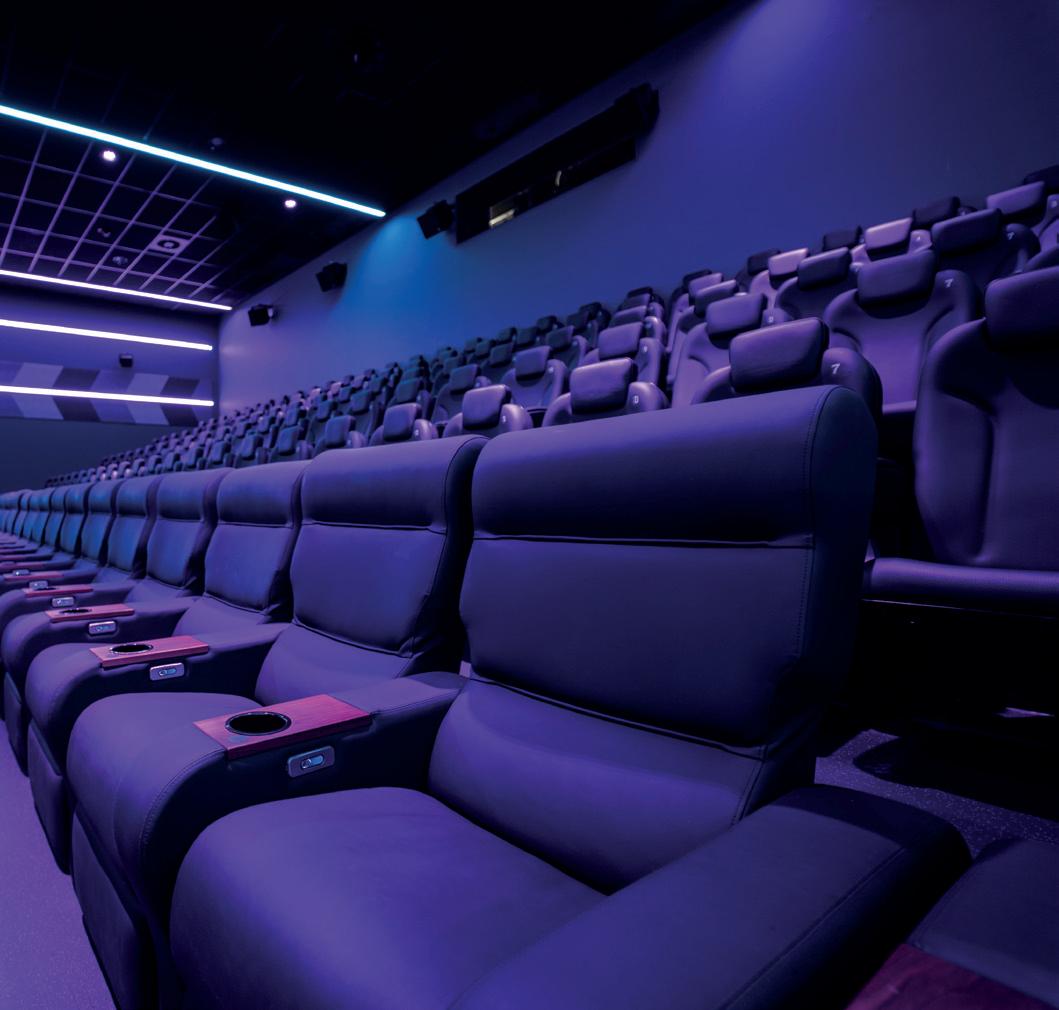
brightness up to 57,000 DCI lumens or 42,000 lumens with an ultra-high contrast lens, 5,500:1 sequential contrast, and an ultrawide colour gamut for real-life colours, it aims to project films as filmmakers intend them to be shown.
With over 260 installations in China and nine in Europe, the CINITY Cinema System has gained significant traction with exhibitors since its debut. Most recently, Spain’s Odeon Multicines reached an agreement to install the system in six premium large format (PLF) theatres across Spain.
more than ten times as much as equivalent lamp-based projectors at the time.

Enter the second generation of RGB laser projectors. Gone are the large footprints of laser devices, now replaced by multipack devices (MPD). MPDs are robust, compact, solid-state laser banks made up of individual emitters in a matrix specifically tuned to accurately reproduce DCI content. With Enhanced Wavelength Diversity (EWD), each MPD features a special configuration of laser diodes that increases the power density multiple times over. The result? Efficient cooling, efficient light coupling, and up to three times the efficiency of a xenon lampbased projector.
The latest CINITY system now uses either one or two CP4435RGB pure laser cinema projectors for medium-sized PLFs and for larger screens, one or two CP4455-RGB projectors featuring Christie RealLaser™ technology for screens up to 33 metres wide. The projectors are equipped with highspeed CineLife+™ processing electronics capable of 4K@120fps playback that creates a sense of realism on-screen. Coupled with

“After seeing the CINITY Cinema System in action at CineEurope in 2022, we instantly realised we had to get our hands on it and bring it to Spain so that our audiences could view and experience movies in CINITY,” explains Luis Millán, owner of Odeon Multicines. “The CINITY Cinema System gives you projection quality like no other, with sharp details and a depth of colour that you’re not used to seeing in commercial film theatres. It makes all the difference, producing a truly immersive experience for the audiences and taking the cinemagoing experience to a whole new level.”
European cinemas have also installed the system, notably Cineplex Cinema Aachen and Mannheim in Germany, Arena Cinema in Zurich and Geneva, Switzerland, with outstanding contracts for five additional theatres by the beginning of 2024.
In addition to delivering an exceptional moviegoing experience, CINITY’s advanced technological capabilities mean that exhibitors are well equipped for future advances in filmmaking and projection – without the costly need to upgrade equipment – and deliver an exciting, immersive, and shared experience for moviegoers to enjoy.
And that’s worth leaving the house for.
This article explores opportunities to grow cinema advertising revenues. While doing so, it leaves the fascinating question of how to boost cinema admissions aside and focuses on innovations in the cinema advertising space only.
s the global cinema sector continues to rebuild, this article explores the dynamic future of cinema advertising. It illustrates how screen advertising agencies increasingly turn into creative partners that offer more than the traditional advertising pre-show and asks how digital technology transforms the operations and prospects of cinema advertising. The article includes insights from a micro survey of cinema executives and agency leaders, focusing on their views on programmatic advertising. Cinema advertising connects brands with captive audiences in unparalleled, engaging and immersive ways. As Global Cinema Advertising Association SAWA puts it “...albeit small in percentage in terms of main media expenditure, cinema advertising reaches one of the most highly sought after audiences delivered today.” In cinema, brands strategically align with cultural moments that connect audiences across the world. They leverage the emotive power of film to resonate with guests in a controlled environment, where brand safety concerns are not an issue.
Independent research commissioned by screen advertising powerhouse Weischer.Cinema underscores the competitiveness of cinema advertising: 95% of all advertising seconds in cinema were attentively viewed. On the other hand, the corresponding figure was only 55% on TV and only 25% for online video. Weischer. Cinema’s research also showed that cinema commercials appeal to audiences more intensively in emotional terms than TV or online video. Both findings justify the premium price that advertisers pay for showing their spots on the big screen. Whilst global advertising spend on TV or online video dwarfs global cinema advertising spend, it is an important revenue source for cinema operators. However, similarly to Box Office revenues, global cinema advertising spend has to yet again reach prePandemic levels. According to groupM, a leading media agency, that threshold - estimated to be somewhere between 2,5 and 3 billion $ per year - will only be crossed in 2026.


o help us better understand key trends and sentiments about cinema advertising, we created The Future of Cinema Advertising Micro Survey, 17 questions asked to industry executives with a stake in cinema advertising. A quick hat-tip to cinema advertising icons Pearl & Dean, who just turned 70 years old. In a recent feature for Cinema Technology Magazine, Peter Meehan skillfully outlined the century-long evolution of cinema advertising. He illustrated how it mirrored changes in society and technology, starting with static ads on fire curtains, moving to sound-filled propaganda films during WWII, and evolving to the 15-30 second ads we know today. Pearl & Dean CEO and SAWA President Kathryn Jacobs then reminded us that cinema advertising involves more than putting together and selling the pre-show. At Pearl & Dean, it includes tailor made brand partnerships and activations, such as food-tastings, popup promotions or 360° immersive events that take over an entire movie theater, including its media channels. Diversification of course is also taking place in the wider cinema exhibition industry, where operators launch Event Cinema offers, ladies nights, Premium Large Formats, immersive seating, boutique concepts, in-theater dining, mixed-use entertainment venues and other innovations to meet ever-more fragmented audience demand and lure patrons to the cinema. In our micro survey, we asked if this diversification of the cinema experience in turn impacts cinema advertising. While 60 percent of respondents agreed almost 30 percent disagreed. Here are two responses:
“All mentioned examples mean more accurate targeting and the potential to hit higher value customers.” Said one respondent.
“These are all niche opportunities that don’t have considerable scale. So, while they are useful experiences to monetize - they can bring in select advertisers who wouldn’t normally use screen time – they are incremental revenue and not the key driver”. Said another respondent.
There is a slight duality in these statements that is also reflected in other responses collected so far: it’s the classic tension between wanting to preserve what we’ve got but also knowing that we need to innovate to evolve. So, what about operational and tech innovations in cinema advertising? Forgive your tech-challenged author for taking a stab at this issue, too:
Today ’s cinema experience is so much more than movies! And Q-SYS is so much more than a cinema processor! With the Q-SYS Platform and QSC loudspeakers, you can deliver sound to each theater and ever y other space in the theatre complex where high qualit y sound is important. Use your theatre for conferencing, business presentations, eSports and other live events. Plus, control and monitor sound system components, projectors and may other devices remotely from anywhere with a net work connection










Market research insights

“DCP (or JPEG2000) is a far superior standard to MP4 both from a quality perspective and a versatility perspective and ensures compatibility with the playback devices in cinemas.”
“Really no difference in quality any more (actually tested it) while mp4 has a lot of advantages…”
In-house data from ticket sales, websites, Social Media accounts
Insights derived from facial recognition technology
Insights from cinema related apps, gaming solutions, etc.
Geolocation and mobility data
The question is, then, if programmatic could further revolutionize cinema advertising in the future? Conversations with cinema executives showed that some doubt the
Cinema advertising usually relies on prebooked slots and direct sales teams to negotiate ad placements, contrasting with the real-time bidding and automated placement of programmatic advertising.
Programmatic advertising, focused on efficiency and scale, might conflict with the premium, curated nature of cinema advertising.
The highly targeted one-to-one approach of programmatic does not work when a group of diverse patrons gathers in a cinema auditorium.
The current standard format for delivering cinema advertising spots to cinemas is the DCP (Digital Cinema Package), which
ensures a great picture and sound quality of the ad as well as seamless integration with the wider show. Real-time-bidding by advertisers for the opportunity to present their ad to a specific audience is difficult with the current DCP infrastructure.
The final point resonates in an industry renowned for offering unmatched cinematic experiences. While some premium advertisements do leverage D-Cinema’s immersive audio and HDR to enhance their impact, there’s a debate over whether other ads could be similarly effective in MP4 formats. A potential shift from DCP to MP4 sparks concerns – amongst some – that it could dilute the value of the pre-show, leading to a diminished experience for viewers.

Perhaps surprisingly, then, were the responses to our question if Programmatic Advertising would in the next 5 years increase the overall revenue from screen advertising.
33 percent of respondents replied definitely yes while 48 percent replied probably yes. 14 percent replied with not sure and 5 percent suggested that this would probably not be the case.
Premium brands are increasingly interested in the programmatic space. In a recent interview, Josh Wilson of media agency Dentsu commented “There has been an uptake in spend across programmatic activity for luxury buyers, who are reaping the benefits of things like transparency, consolidation, and performance.”
DEFINITELY YES
33.3%
PROBABLY YES
47.6% UNSURE 14.3% PROBABLY NO
4.8%
et’s explore how a few key stakeholders in cinema advertising approach programmatic:
US market leader National CineMedia last summer announced it would, next to offering direct buys, in the future also start selling ad inventory programmatically in private marketplaces and on the open exchange. The main motivation was not to sell “remnant inventory at last minute”, according to NCM Chief Revenue Officer Mike Rosen, but to embrace new digital advertisers looking for high-quality and premium advertising opportunities. NCM bets on programmatic opening the door to new brands willing to pay a premium to capture the attention of cinema audiences.
Importantly, National CineMedia ties its programmatic proposition to the opportunity to retarget cinema audiences through its data analytics platform NCMx, using first-party data from ticket sales, loyalty schemes and mobile apps. NCM then works with third-party data providers to tie ad exposures to instore foot traffic and sales. Finally, it works with Youtube and Yahoo so brands can retarget audiences on these platforms, too.
Cinema advertising has long been celebrated for making people aware of brands and building loyalty. What the developments at NCM show is that it can now also encourage purchases by targeting audiences again after they’ve seen an ad, effectively boosting conversion.
Rewinding to June 2022, we observed the inaugural
programmatic cinema advertising transaction facilitated by Weischer.Cinema. The German screen advertising agency announced its provision for automated ad booking and playback for advertisers—a global cinema industry first. In addition to the classic criteria of location, day, and time, this initial phase allowed for audience-specific targeting based on gender, age, education, and income. Since July 2023, programmatic customers have the added capability to target their cinema audiences based on affinities, interests, purchase intentions, or a propensity for change, utilising MBI data that delineates mobile phone-based movement profiles within microcells. Nearing the close of 2023, Weischer expanded opportunities for potential digital advertisers to purchase cinema inventory programmatically by partnering with media buying platform, The Trade Desk.
And Weischer.Cinema has been innovating in another advertising-related domain. It’s REDyPlay app (owned by Cinemataztic) offers cinemagoers the opportunity to use the big screen for social videogaming, minutes before the pre-show starts. The gaming solution - available in more than 200 screens in Germany - also ties in advertisers and is another attempt to learn more about cinemagoers and in turn attract digital advertisers.
Cinemataztic’s goal is to enable the cinema advertising community to navigate its next phase of innovation by connecting cinema with the digital advertising ecosystem. Cinemataztic has developed a suite of solutions and games to engage and entertain audiences before the pre-show and involved brand partners such as McDonald’s, Virgin Mobile and Samsung to launch their offer. They also operate a programmatic product – CineAd. The profiled cinema audience is offered via the Supply Side Platform (SSP) and matched with the advertiser’s targeted campaign on the Demand Side Platform (DSP) before the advertisment is finally played out on the cinema screen via the Cinemataztic infrastucture. Everything is done in real time and the profiled cinema audience is offered via the Supply Side Platform (SSP) and matched with the advertiser’s targeted campaign on the Demand Side Platform (DSP) before the advertisment is finally played out on the cinema screen via the Cinemataztic infrastucture. Everything is done in real time – just before the classic preshow starts - and content is delivered in MP4 format.
This article described three similar but also different approaches to embracing advertisers interested in programmatic advertising to also consider benefiting of the premium benefits that cinema advertising offers to brands. Will any of them succeed and become a more significant part of cinema advertising’s future? We’ll continue to ask the question over the next few months and invite anyone interested to continue the dialogue with us. To that end, we are organising a workshop, The Future of Cinema Advertising Lab, at CinemaCon. If you are interested in joining the conversation email Jan Runge (jr@ janrunge.com) to register for the event taking place on 10th April from 11:00 – 12:30 in Palermo Room at Ceasars Palace.
Digital
NC603L Laser Cinema, Silent, Sealed, Sustainable
Deliver captivating movie experiences with our NEW ‘Super Silent’ NC603L Laser Projector. Ideal for boothless and Silent Cinema, with an unrivalled noise level below 39dB, 6000 Lumens and a dedication to lifecycle sustainability.
Incorporating the highly efficient latest Laser technology, low power consumption of only 0,89kW, advanced dust protection with sealed engine and laser light source, 50,000 hours Laser life time and lenses interchangeable with the NC1000C family, it’s the perfect choice for longer term performance!
Discover more at sharpnecdisplays.eu
Award winning Lumma founded in Argentina, is a pioneering company dedicated to revolutioniSing the cinema industry through cuttingedge technologies and immersive multi-sensory experiences. Lumma is responsible for the creation of 4D E-Motion, a state-of-the-art theater system designed to transport audiences into a new dimension. Equipped with motion seats and outstanding special effects, it allows movie-goers to experience wind, water, vibration, scents and air shots among other effects, perfectly synchronized with the on-screen action.


founded in 2014 by visionaries Antonela Salvador, Gabriel Castarés, Marcos Franco, and Sebastián Franco, embarked on a journey to revolutionize theme park attractions through cuttingedge technology crafted by their creative engineering department. Driven by boundless passion, they started looking to innovate in special formats that go beyond audiovisual limits.
D E-Motion was developed by its founders together with its interdisciplinary team in Argentina and Canada, and turned out to be one of the most immersive experiences for moviegoers. The First 4D E-Motion theater was installed in Argentina in 2016. Since then, Lumma has introduced its technology in 14 different countries, captivating audiences in a diversity of regions, such as Latin America and the EMEA territory and continues to expand into new markets.
Lumma has partnered with a number of leading cinema operators including Cinepolis, Cinemark, Multicines, Caribbean Cinemas and Megamara -among others- offering robust and solid technology with worry free maintenance, which is highly praised by the exhibitors. Lumma offers turnkey project installation from feasibility studies through to theater adaptation, development, production, installation, and technical support worldwide.
Lumma Audiovisual Engineering Lumma Audiovisual Engineering, Fact File 4 Peter Knight, Commissioning Editor, CTMAt ShowEast 2023
Lumma received the prestigious inaugural Technology Award, celebrating innovation and excellence in cinema technology. The award was presented by Tonis Kiis, Senior Vice President of International Distribution at Warner Brothers.
Lumma´s 4D Sync Department in North Hollywood has a team of skilled artists and technicians, specialised in 4D Technology, with a deep understanding of cinematic language that enables a seamless integration of the 4D narrative elements.
The accurate artistic criteria for the synchronisation was built together with the studios representatives, who have been playing a key role in the process and continue to contribute to its development. Since 2016 Lumma has synchronised over 300 movies, releasing the biggest blockbusters of various genres and engaging the audience in a cinematic experience never seen before. This year, the 4D E-Motion lineup boasts nearly 60 movies, featuring a rich variety of genres. Their range of content doesn’t stop at thrilling action Films but it extends widely into horror, animation, live action, sci-fi, thrillers, adventure, and much more. Each 4D E-Motion movie offers a unique and unforgettable experience. Upcoming titles curated for 4D E-Motion include: Madame Web, Ferrari, Aladdin, Kung Fu Panda
4,, Ghostbusters: Frozen Empire, Godzilla vs Kong: The New Empire, Kingdom of the Planet of the Apes.
Guaranteeing equipment performance has become part of Lumma’s mantra. With every system, Lumma installs a redundant control system to guarantee the seamless performance of every single show. The system includes a remote alarm and monitoring suite to anticipate any issues that may arise. This almost guarantee of quality performances has led to Lumma’s exhibitor partners remaining satisfied with both the quality of the 4D experience and the technology performance and given them confidence to keep expanding the format with Lumma creating a true partnership.
4D E-Motion experiences have consistently led to higher attendance numbers as moviegoers are drawn to the unique and captivating cinematic environment. This surge in ticket sales, combined with the upcharge price has even contributed to enhanced revenue streams.
Exhibitors have been able to implement premium pricing models for immersive seating, allowing them to double the price for an upgraded movie experience. This adds to the overall ROI. The final result varies from country to country. In

some cases, exhibitors have been able to recover the investment in 2 to 3 years.
Lumma highly recommends implementing a complete theater, ideally with between 80 and 120 seats, as 4D E-Motion theaters of this capacity consistently boast a high occupancy percentage. However, if this option isn’t feasible for the complex, a hybrid room offers a viable alternative. This new concept preserves the traditional layout of the theater and its seats while incorporating a few rows of 4D E-Motion seats and their effects. A designated section of the theater is adapted to seamlessly integrate the equipment without compromising functionality. In this setup, audiences have the option to choose between purchasing a 4D ticket or watching the film in a conventional seat. Since this technology does not require a special technical room, installation is straightforward and the Lumma team collaborates closely with exhibitors to plan and execute the layout to perfection, ensuring the best personalised experience for their attendees.


“Exhibitors have expressed interest in this alternative for several years, as they seek conservative investment options that can still enhance the cinema experience,” explains Antonela Salvador, Creative Director and Founder at Lumma. “The hybrid theater is ideal for complexes that have fewer screens, with the possibility of continuing to add more rows gradually in the future. Once they know the format, the public tends to choose to see titles in 4D and if capacity is limited, the exhibitor will probably request the addition of more modules over time. That is why planning with the exhibitors is important to make the best proposal adapted to each case. There are already three theaters following this concept with several additional projects planned with the same approach,” she adds.
Post-pandemic, there has been a noticeable industry shift towards premium experiences, something noted by Lumma. “After a period of limited entertainment options and social distancing, consumers continue to seek novel and exciting
 The Lumma 4D seat
The Lumma 4D seat
experiences. With 4D E-Motion, it offers a unique and captivating way to enjoy movies beyond the experience at home, making it an attractive option for those looking to break away from their routine. Movie goers are now looking for more than just a movie; they want an unforgettable, multisensory adventure that transports them to new realms of entertainment,” Antonella explains. In an ever-evolving entertainment landscape, where competition is fierce and digital streaming platforms offer convenience at home, cinemas need to continually up their game. Premium formats, like 4D E-Motion, are a strategic move in this direction. They provide a unique selling point for theaters, making the cinematic outing more enticing than ever. By offering these compelling and immersive experiences, cinemas cannot only retain their relevance but also thrive in an industry that’s constantly changing. So, the decision to embrace premium formats is not just about staying in the race; it’s about leading the way into the future of entertainment.
“Premium formats are becoming the frontrunners. The entire complex benefits from having a theater with new features. The reason for this enthusiasm is clear: premium formats such as 4D E-Motion elevate the entire cinematic experience. They take moviegoing beyond the ordinary, turning it into a thrilling adventure,” Antonella concludes.
As has been demonstrated by a number of exhibitors around the world, adopting new technologies in the cinema industry is

crucial for remaining competitive, attracting a broader audience, and providing unique and memorable experiences. 4D E-Motion is well positioned worldwide and has a level of support and trust of exhibitors that will enable the business to drive through innovation whilst expanding its global footprint. Recognising industry trends, Lumma continues to invest in building relationships, product development and innovation all with a view to offering unique and unforgetable cinematographic experiences to audiences around the world.
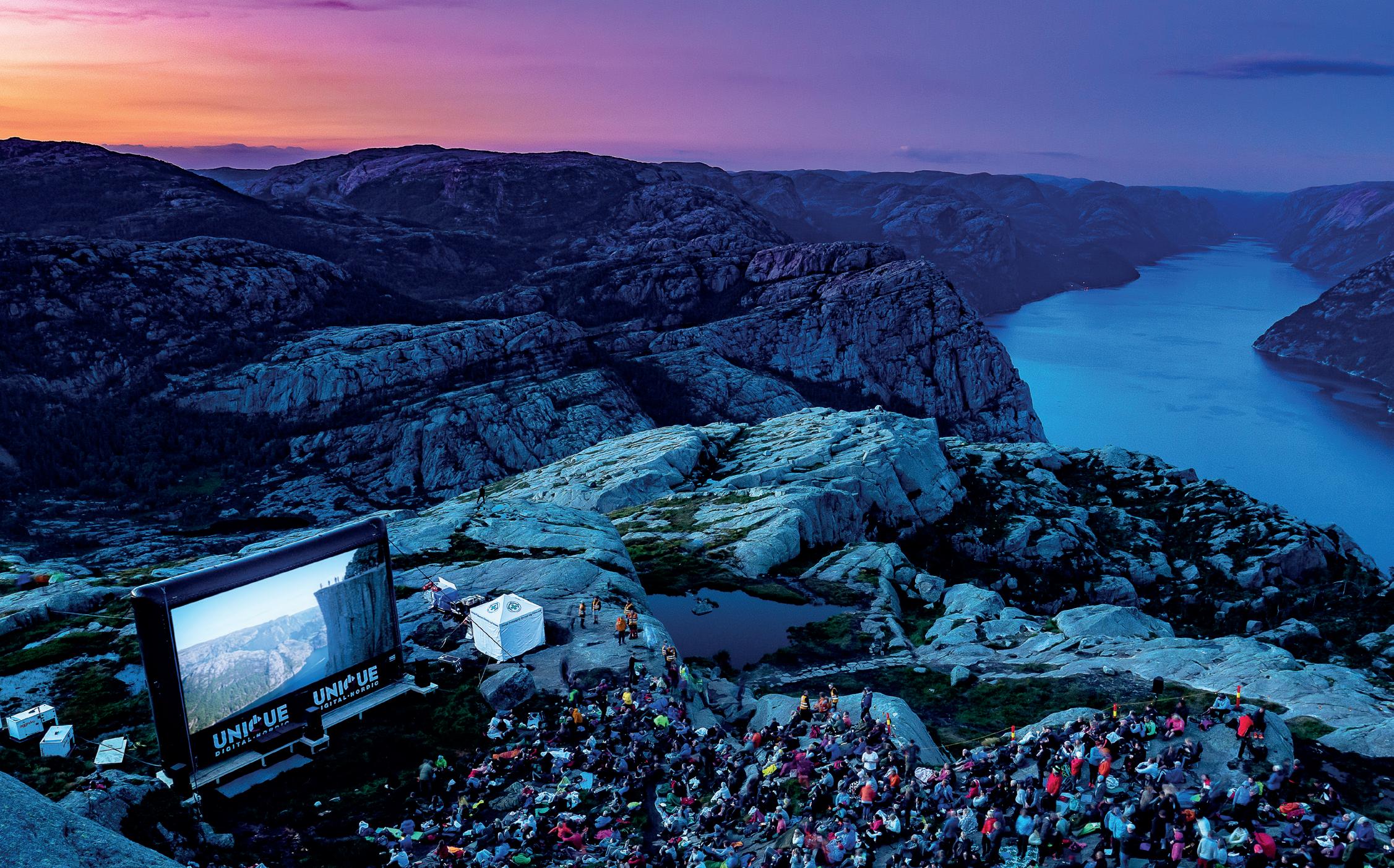





The cinema within the iconic Channel 4 office building near Victoria has recently been refurbished. Peter Knight spoke to both integrators Sound Associates and the Channel 4 team to discover more.
Channel 4 television started broadcasting to the United Kingdom (except Wales) on 2nd November 1982 at 17:00 with the programme Countdown. It was the first new television channel in the UK since BBC2 in 1964, nearly two decades earlier. In 1994, Channel 4 moved into its new headquarters on Horseferry Road, near Victoria Station in London, a now iconic building that was designed by Richard Rogers, the same architect who designed the Lloyds Building and Millenium Dome (in London) as well as the Pompidou Centre in Paris.
During the design and construction phase of the Channel 4 offices, there was provision made for a cinema on the lower
ground floor. This was separate from the Film 4 offices and screening rooms that were initially elsewhere in London at the time. The Channel 4 cinema was initially used to present preview screenings of television programmes to both internal and external guests. Over the years, this has evolved to include other events, presentations, conferences and talks. The cinema auditorium has 70 seats, with a small low stage, lectern, and comfort monitors for presenters and onstage guests, while in the projection room there were two 35mm projectors, along with a Series 2 NEC Xenon projector, a Dolby Server, Folsom, and DVD, BluRay and AVID playback and other equipment. Most of the content that was played back was done so via a Folsom and Creston system, with several different monitors and preview monitors in the projection room.

Like several multi-functional cinemas and preview theatres that constantly add new equipment to an already existing system, it gets to a point where it needs to be reassessed and the system rebuilt from the ground up. During the summer of 2023, Sound Associates refurbished the entirety of the equipment in the projection room, alongside a major refurbishment of the auditorium to install a Dolby Atmos system.
Channel 4 wanted to have projection and audio equipment that was both modern and efficient, that could cope with all the demands of the current system and presentations, alongside making sure that the system could be future-proofed by being able to be expandable as required.
Apart from the desire to modernise the system there was also an eye to reducing the environmental impact, that in turn also offered a reduction in energy costs as a result. This was

achieved through the selection and installation of modern equipment that is both more energy efficient, such as an NEC laser projector and modern amplifiers that utilise less power, while also installing a new control system that allows for equipment to easily be turned on and off as required.
As part of the project planning, all the different system elements were mapped out in order to optimise the number of pieces of equipment in the audio visual chain and thus reduce both the potential opportunities for failure, but also the number of pieces of equipment that need to be used. This has helped to make a more efficient system, both operationally but also environmentally. A new simplified system makes it easier for the projection team to manage.
As part of the refurbishment, Channel 4 wished to install Dolby Atmos. The auditorium, however, is not a standard rectangular space with high ceilings. The Channel 4 auditorium is a

fan-shaped space that includes a number of hidden doors, alongside a relatively low ceiling, that also alters in height around two thirds or the way back. Added to the shape of the auditorium is that the room itself is covered in hard metal cladding. All of these design features from the original architecture meant that the team at Sound Associates had to work closely with colleagues at Dolby in order to identify the optimum placement positions of speakers to ensure coverage was achieved.
With the two different ceiling heights and the lowest near the projection port, ceiling speaker positioning was critical to ensure they do not interfere with the projection image. Splaying to top surrounds to match the room shape helped to overcome this. The audio system is now bi-amped and has three subwoofers placed behind the screen for LFE. Behind the screen also houses two surround subwoofers. All speakers are QSC along with QSC amplifiers and QSC audio processing.
The projection room has been completely stripped out, including the two 35mm projectors which had not seen much use in recent years and the additional space they provided allowed for easier access to the new digital projector, as well as being able to provide space for additional audio racks.
A new Q-Sys system providing 32-channels of audio was installed into these new racks, alongside microphone receivers, used for presentations and a new Sennheiser audio description system. On top of these racks is a new digital mixing desk that is used during presentations to manage all the playback volume levels, along with the PA system. This reduced the need for an additional mixing desk that was previously placed at the back of the auditorium. All the audio mixing can be controlled from a tablet device so that an operator can sit discreetly at the back of the auditorium to monitor sound levels either during rehearsals or a live show. The DCP projector was upgraded to allow 4K

playback of both DCP and non-DCP content. The replacement 4K Laser, NEC NC1843L projector replaced the series 2 NEC xenonbased projector. However, with the auditorium screen being just over 5m wide the light output of this new projector made it far too bright for the environment. The screen was replaced with a new 0.8 gain woven surface, with the projector also running at its lowest possible power setting in order to achieve suitable brightness levels. The woven screen helps to eliminate any chances of moiré effect that can sometimes be present on perforated screens where the pixels and perforations line up. Alongside the new projector is a new IMS, replacing the old Dolby DSS200 server. Working in tandem with the new Dolby IMS3000 is a Dolby 4 x 4TB network storage system that provides the Channel 4 projection team with plenty of storage space for all the DCP content that they need for playback.
While it is important for the cinema at Channel 4 to be able to playback DCP content, a vast amount of the time, the cinema is used for non-DCP content. This can be anything from a Microsoft Teams call, or a Keynote or PowerPoint presentation from the lectern, a Q&A session on stage with clips, or the playback of a forthcoming television programme from the AVID system. These requirements mean that the technical team needs to be able to use the cinema audio system with a separate PA speaker. Sound Associates collaborated with Production Bureau to provide a new QL5 mixing desk with an audio fold back system and Sennheiser radio microphones. The mixing desk outputs directly to the Q-Sys system where this in turn can output the audio to any speaker array or to a separate PA audio system.
Alongside the implementation of the new sound system and routing there was an opportunity to make the audio and visual switching system more efficient and easier to use. Sound Associates used the Q-Sys system to create a customer user interface system for the Channel 4 team that can be used on either an iPad or a PC Laptop. With all the system transferring over to IP, it is now possible to easily switch the newly installed IP streaming device to send any of the eight AV sources to any of the auditorium monitors, projection room monitoring screens or the projector, with just the touch of a couple of buttons. The Q-Sys system also allows for the full integration of Microsoft Teams, along with the full control of the audio input and output, complete with audio levels. It also allows for the complete control of the playback functions of the projector and server. The 8-channels of audio are also sent from the new mixing desk for overlays and receive the mixed audio back into Q-Sys.
The complete rebuild and installation of the system also allowed for several other improvements in the system. A new accessibility system was installed from Sennheiser called MobileConnect. This is a “Bring Your Own Device” system
 (Top) Inside the auditorium showcasing monitors, (Right) new UI for controlling the auditorium.
(Top) Inside the auditorium showcasing monitors, (Right) new UI for controlling the auditorium.

where users can use their own smartphone to scan a QR code to connect and use. Once the mobile application has been installed and configured, it works immediately in the auditorium and eliminates any hygiene concerns of shared equipment.The HDMI distribution system has fast switching and is capable of dealing with the various video resolutions that are in use. This consists of a Blustream ACM (Advanced Control Module), a transmitter for each source and a receiver for each monitoring device. Going via a managed network switch, the prepared video sources are always available at a touch of a button. With its own web GUI, the ACM also provides a preview of each feed.
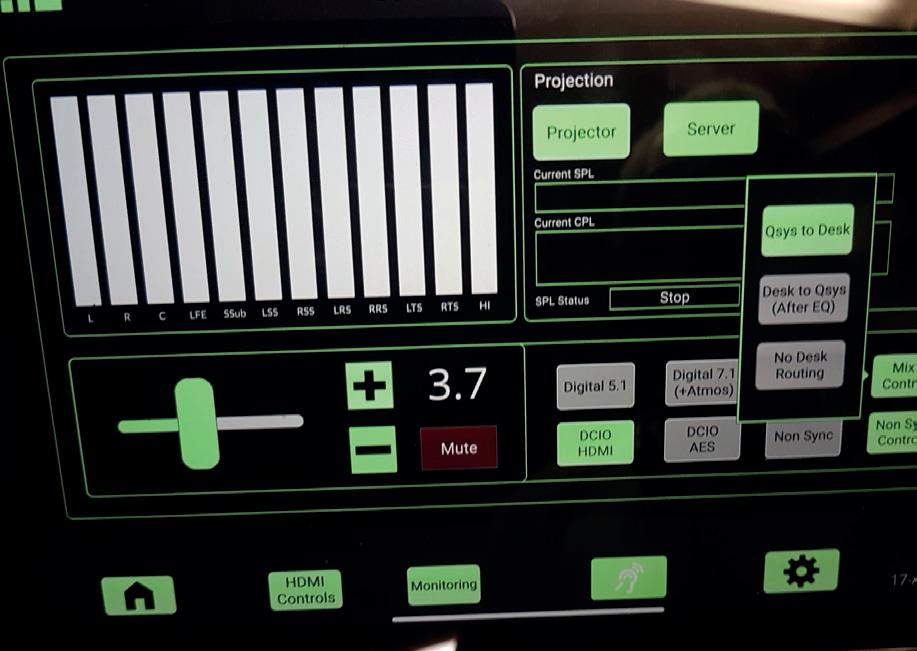
With all of these improvements what do the Channel 4 projection team think of it all? We spoke to Alan Westlake, Cinema Manager who has been working in the cinema for over 20 years and was heavily involved with the design requirements for the project about his reaction to the refurbishment.
Alan, a long-time employee of Channel 4, reminisces about his time at the company and the changes that have taken place over the past two decades. When he first walked through the entrance doors over 20 years ago, he never thought he would still be there in 2023.
“The cinema is used exclusively for C4 and Film 4, with occasional permission granted to external agencies or companies, provided that
the project is related to Channel 4. The technology in the cinema has undergone many changes, from 35mm projection and sound followers to a digital upgrade to DCP Dolby in 2010, complete with a NEC projector and DSS200 server, and 3D. With further advances and a need for an upgrade we were close to signing off on the project before the pandemic struck,” explains Alan.
“The project was revived early this year and we appointed Sound Associates as the main contractor. Their engineers have been professional and helpful throughout and we were able to schedule the work during August, which is a slightly quieter time for the cinema. We had various meetings with Sound Associates, and Channel 4 entrusted me to handle all the technical
aspects of the upgrade including a request for Dolby Atmos from senior management, which was incorporated into the upgrade,” Alan adds.
The cinema has recently held a few screenings with BAFTA-selected films and the main event ‘Mogs’, the Channel 4 Christmas animation from the same stable as the ‘Snowman’ and ‘Snowman and Snowdog’, produced by Lupus Films Ltd. Although not Dolby Atmos, the film sounded great in 5.1 coupled with the NEC 4K Laser projector and QSC sound system. As well as a 70-seat capacity auditorium, the cinema has a great reception space, which is just about to reopen after extensive work on the exterior of the building and will doubtless be used extensively going forward.
As cinemas continue to diversift their offerings, The(Any)Thing cinema is bringing a personalised, boutique premium offering to movie-goers combining eye catching design and service levels to match. CT Magazine sent Toni Purvis to Ypenburg in the Netherlands to look at the newest site from this progressive company.
Toni Purvis, Director, CTCast November, I was fortunate to attend the Norwegian Cinema Conference in Fredrikstad. It’s a conference which always delivers on topics of great interest, but this year one concept held my attention more than anything else. That was ‘The(Any)Thing’. It only seemed fitting to travel to The Netherlands to witness for myself the newest installation of The(Any)Thing. Before we jump into the experience at Pathé Ypenburg, we should cover the fundamentals. ‘What exactly is The(Any)Thing?’, I hear you cry.
Well, put simply, it’s a private boutique screening experience, in which you can view any available movie, and program it at a time that suits you. Crucially, with the help of some ingenious designers and architects, it can be incorporated into practically any space.
So how did The(Any)Thing come to be? I was fortunate to meet with CTO, Ivar Vermeulen, to get the low down.
With a background in video on demand (VOD) at Pathé Thuis, a Dutch streaming company, the co-founders of The(Any) Thing set out with the question ‘how can we combine the experience of cinema with the on demand convenience of VOD?’ Consequently, in 2018, the team built a screening room in Utrecht and set out to achieve just that. After rigorous testing, it became evident that the audience also wanted to be able to screen the most recent theatrical releases. Ultimately this led to investment in DCI compliant equipment, and the process of bringing both Hollywood and independent studio content to the offering soon followed. It was a hit. Fast

forward to today and The(Any)Thing can be found in Wijk bij Duurstede, Hotel New York - Rotterdam, and inside Pathé Ypenburg - The Hague. Each of these venues houses the screening rooms in a completely unique space. Whether it be a defunct function room, a hotel basement, or a spare auditorium in a multiplex, The(Any)Thing’s adaptability allows for installation to occur practically anywhere. The(Any)Thing x Pathé Ypenburg is the first private cinema to be housed within a multiplex, which is quite the accolade. So let’s dive in.
To borrow from The(Any)Thing’s vision statement, they aim to blow people away with an experience that is unlike any other cinema. That feeling starts as soon as you walk into the bar area which serves as the access point to The(Any)Thing screening rooms at the Pathé Ypenburg. The bar itself is curved and

ribbed, borrowing from the art deco era. The lamps are oversized LED bulbs omitting a soft hue, meeting the needs of the energy conscious without sacrificing style. The colour scheme of greys, blues, and golds all feed into the atmosphere, creating a relaxed space only metres from the hustle and bustle of the main multiplex. Pass the bar, and you can find several comfortable sofas, chairs and tables. The ceilings are high, the windows are huge, letting in plenty of natural light or allowing you to view the twinkling lights of the town depending on the time of your visit. It’s an incredibly pleasant space in which to relax before or after your movie, whilst pondering the bar menu, of course. The food and beverages on offer are worth acknowledging. The drinks menu features an array of wines, beers, cocktails, bubbles, hot drinks, and soft beverages.

The food menu is similarly extensive, with anything from olives to bitterballen being available to you. Fear not! Popcorn is also on the menu, but it’ll be served up to you in a swanky bowl rather than the cardboard cartons we’re familiar with.
As you enter the lobby, you are greeted by a futuristic scene. The colour palette is the trademark electric blue of The(Any) Thing brand, and yellow which Ivar confirmed is a respectful nod to Pathé. On the ground level is the lone five-seater room, aptly named ‘The Five’, the outside of which is mirrored, serves to add the illusion of more space and light in what is ultimately a concrete room. Head up the stairway to find five separate rooms each called ‘The Blue’. These are all two-seater rooms, perhaps unsurprisingly, clad in blue soft furnishings. Each screening room has a digital display outside which details what the next screening is, and who has booked the room, making it easy for the customer to identify their booked space. Inside each screen, we see a continuation of the juxtaposition between modern clean lines with the curvilinear characteristics of the recliners, each of which has independent controls. There’s a moveable armrest for each of the sofas so you can be as close to your loved ones as you dare to be. Each seat has a side table for your food and beverage orders. There’s a novel coat hanger on the wall so you can really make yourself at home. With regards to technology, you can’t really see any. The speakers are hidden behind the acoustic paneling, and the projector is out of sight. Ivar explained that this was a deliberate design consideration. The aim is to have the audience as immersed and as comfortable as possible, without the distraction of technology.
Behind each screening room, one can find an immaculate projection booth housing a Barco SP2K-7 which is marketed as a

projection solution for the smaller screen. The audio processor is the Trinnov Ovation2, coupled with Procella speakers and amplifiers, offering a 7.1 experience. Procella has historically been known as a home cinema brand, which makes them perfect for these living room replicas. I was given a demo, and I can confirm that all of my needs were met. The light was ample, the contrast on point, the audio brilliant. The(Any)Thing has got the basics of cinema technology nailed down. It’s simple, effective, and of great quality, which is all I personally ever want.
So how do we book? Download the app of course!
Via the app, you can find an array of titles to choose from. There are currently 1000 movies available with that set to only grow. You can access library titles such as ‘The Founder’ or ‘La La Land’, or perhaps you want the most recent blockbuster. That’s doable too. What is quite unique is that The(Any)Thing also spans the availability lull between ‘in theatres now’ and ‘now available to view at home’. Although that window is becoming shorter, The(Any)Thing offers an effective solution to that problem. Booking can occur up to eight weeks prior to the screening date which allows for planning, but you can also book as little as fifteen minutes ahead of time. There are several factors that need to align for such a short notice booking, such as the content already being present on the server and an active KDM being available. Much of the content is stored locally and can be pushed to the relevant screen with ease. The system will not allow you to book a movie that will not be ready in time.
The booking system itself works on a first come, first served basis. If you want to watch a three-hour film at noon on Wednesday and that slot is free, then you can book it. Any other bookings that come in later will need to work around the existing bookings. You may think that this could put too much control in the hands of the user when it comes to filling the
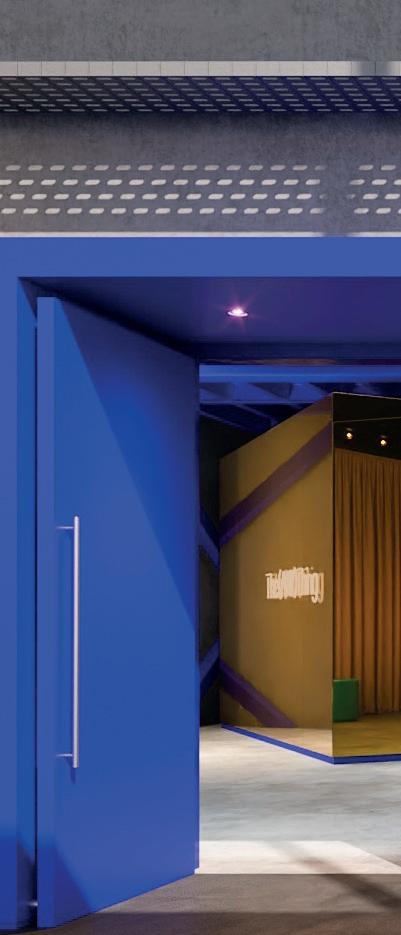

bookings calendar for the day. For instance, someone books from 12 until 3 and then another from 5 until 8 which essentially leaves dead space between the two bookings (let’s be honest, movies with a runtime less than 2 hours are far and few between). However, at the Ypenburg site, you do not choose which of the five two-seater rooms you are allocated, which means you are programmed into the one that best fits your film duration, thus optimising daily occupancy. On average, each screen is seeing 4 bookings a day, which shows that The(Any)Thing platform works well.

Once you’re in your private screening room, your app becomes your remote control. From your phone you can dim the lights, alter the volume, order your food and beverages and importantly, pause the movie. Fifteen minutes of ‘pause time’ is built into your booking slot. So, if Uncle Trevor needs to be told which character is which and how they fit into the story (again), you can pause the movie and explain it all without missing a second yourself. I suspect the pause time is more conventionally used for comfort breaks. Point being, it’s your time, do with it what you will!
Surely all of this convenience and style is going to come with a hefty price tag for the audience. That’s what I thought anyway, but I was pleasantly surprised. The cost does depend on the room, time, and duration of the booking but if I were to book a 2-seater room, on a weekend morning for 3 hours, we’d be looking at around €59. It might not be the cheapest, but it’s not out of reach.
We are in an era where the audience wants an experience at the cinema and are willing to spend time and money on the right product. We have seen a rise in focus on luxury seating, increased food and beverage offerings, and a move towards a frictionless cinema experience. The(Any)Thing meets all of these criteria with the added benefit of it being a private space, transcending the traditional cinema going experience. It offers luxury without an immense price tag, allowing for a memorable experience whether that be for a special occasion, or just because you’ve had a tough week and deserve a treat. The(Any) Thing is a highly innovative company and concept, and I have no doubt that they will continue to push the boundaries. I’m certain that we will be seeing more screening rooms soon, so watch this (any)space!
Jeff Benson is known as a pioneer of the Cinema Entertainment Center concept, which grew out of a long-term relationship with Neil Hupfauer of Main Event.
The Bensons started in the industry by constructing two cinemas, the first of which opened in 1999. They also founded the Movie Tavern chain of dine-in theatres which opened in 2001. In 2005, the Bensons recapitalised the company by entering into a joint venture that allowed Movie Tavern to become the largest and fastest-growing operator of dine-in theatres in the US.
The Bensons sold their interest in 2008. At the time of the sale, Movie Tavern operated 98 screens in 12 locations across 5 states.
Cinergy Entertainment Group, Inc., crowned Top Family Entertainment Center of the World in 2019, is a one-stop entertainment experience providing movies, games, attractions, food, and beverages for guests of all ages. Cinergy is a family-owned and operated company cofounded by Jeff Benson and his wife, Jamie. It has 9 luxury cinema and entertainment centers in Texas, Illinois, North Carolina, and Oklahoma with a total of 82 screens.

In the summer of 2009, the Bensons opened the first Cinergy location in Copperas Cove, Texas (and have continued to expand since). At that time, there were no corporate or theatre staff, so in addition to preparing for the grand opening, they were responsible for hiring and training all personnel, along with managing the construction of the build. However, they soon learned that setting up a new theatre was the easy part. Cinergy’s first location was open seven days a week and required constant attention from the Bensons, the staff, and local management, which was a continuous learning
www.cinema-technology.com
process for all parties. At the time, the Bensons had already built and sold Movie Tavern, but did not retain any employees once it was sold, so starting over was quite the challenge. The Bensons and the dedicated Cinergy team were putting in 18-hour workdays for many months to learn everything about running a successful theatre company from the ground up.
Through their experience with founding Movie Tavern, the Bensons had a deep understanding of the key constituents of the business notably the movie and food & beverage components, but the Family Entertainment Center (FEC)

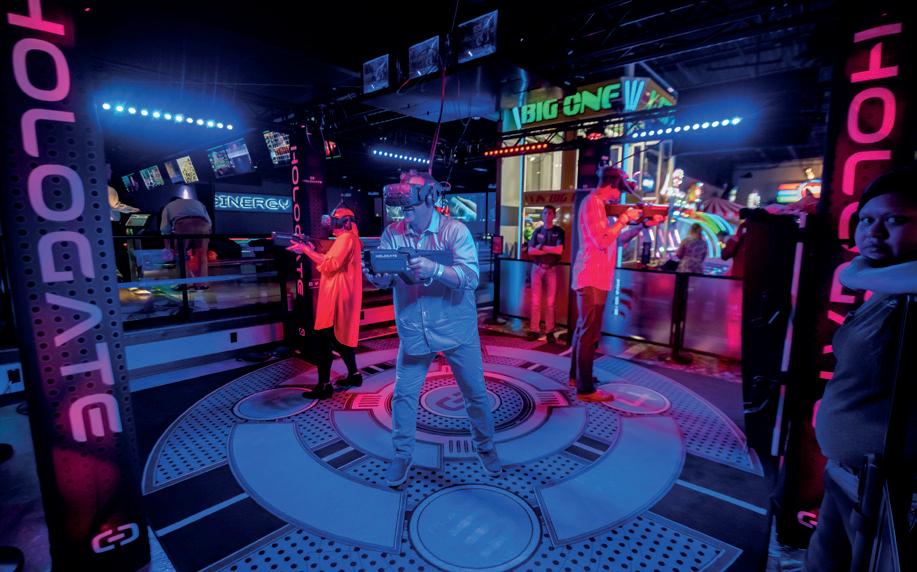
business was a whole new ecosystem to learn and navigate. They had to learn all the aspects of running games, attractions, and amusements such as bowling, arcade games with redemption prizes and laser tag, to name a few. Imagine learning how to fix every single game on the arcade floor in case it needed a repair. It was no easy feat but perhaps the biggest and best surprise for Cinergy was discovering how much their guests enjoyed the mix of games and amusements with movies. Cinergy’s FEC model experienced extraordinary success, which fueled the company’s rapid growth.
Cinergy offers so much more than traditional cinemas or even dine-in cinemas. All Cinergy locations feature luxury reclineand-dine cinemas with alcoholic beverages, These auditoriums feature zero-gravity, heated, luxury recliner seats, Barco laser projection, and Dolby Atmos sound. and most include a menu of chef-inspired American favourites plus craft beer and

cocktails, all delivered straight to the patrons theatre seat. The sites also include bowling lanes, gaming area table, or even to the outdoor patio by the fire pits.
In addition to upscale cinema amenities, Cinergy’s FEC locations feature a unique selection of interactive games and a variety of other amenities, including bowling, axe throwing, laser tag, escape rooms, Virtual Reality, and elevated ropes courses with zip lines. Frankly, Cinergy has very little in common with traditional cinemas other than the movies playing in its auditoriums. The amusement portion of its centres, which totals more than 50% of the overall square footage, is closer to an indoor amusement park than a movie theatre.
After emerging from the global pandemic, it was clear that everyone


was looking for out-of-home entertainment, but theatrical releases were severely impacted. The exhibition industry relies on new releases to draw in the crowds, and it faced another similar earnings crisis with the prolonged writers’ strike. Though the movie recovery has been uneven, the Family Entertainment Center portion of Cinergy’s business has proven to be the magic of the company’s concept. While each of Cinergy’s locations shows the latest movies and blockbuster hits, there are so many other reasons for guests to come and enjoy its facilities. This robust mix of different attractions is a large draw in itself and it does depend on a robust movie lineup to thrive.
Cinergy considers its staff to be the lifeblood of the company as they are the direct connection to its guests. “We are blessed to have a very stable and phenomenal management group in all of our locations,” says Jeff Benson, CEO & Founder. “The General Managers and Assistant General Managers do a fantastic job instilling our culture into our staff and directing them to provide a great experience for our customers. We are constantly training on specific aspects for each of the different positions within Cinergy. Training is not an isolated activity that we do from time to time – it’s how we operate every day. Whether it’s safety training, technology training, or training for stellar customer service, we are always thinking about how we can improve.”
Cinergy is constantly looking for new ways to grow and innovate, but only when it makes sense to do so deliberately and diligently.
In 2024, Cinergy launched its elite membership program.
Cinergy cares deeply about the importance of community. Since 2009, Cinergy has found innovative ways to use its properties for meaningful causes. Here are just a few of the many ways in which Cinergy champions for its underserved communities and those in need, including:
ANNUAL TOY DRIVES: All of Cinergy’s locations hold toy drives for the holiday season. In the past five years, Cinergy has spread holiday cheer with thousands of toys gifted to families across the country.
ON VETERANS DAY: Each year, Cinergy shows its appreciation for the brave men and women who have served in the armed forces by gifting them with free movie tickets.
Once a month Cinergy provides a free, family-friendly movie screening featuring brightened light levels, reduced sound volume, and room for guest interaction and movement.
ANNUAL FOOD DRIVES: Cinergy partners with local food pantries to organize community food drives at all of its locations. In 2021, Cinergy donated one ton of canned food.

The initiative leverages technology to integrate every aspect of the guest experience. Cinergy’s custom-built mobile app and website enables seamless ticket purchases, food and drink orders, attraction reservations, and membership management. The Cinergy system integrates point-of-sale systems, enabling QR ordering throughout the entertainment center. The app also facilitates member rewards, benefits and discounts, creating a comprehensive and user-friendly experience for guests. “At Cinergy, we strive to push boundaries with our technological advancements in the theatre and family entertainment space, and our new app is a reflection of that,” said Nathan Hunstable, CTO of Cinergy Entertainment Group. Recently, the company purchased two Regal Cinemas locations in Texas, one in Midland and another in Amarillo. The team is working on plans to convert the existing theatre into a FEC, which will undergo a complete overhaul to include luxury, recliner seating for the movie auditoriums, a full kitchen and bar, a game room, and bowling alleys, along with several other new and state-of-the-art attractions which are still under wraps. Additionally, the team is working on a brand new location in Texas for a 90,000 square foot luxury Cinema Entertainment Center. www. cinergy.com

After completion of the restructuring and streamlining of The International Moving Image Society, we recently activated more new functions and operations in January. It was very satisfying to receive comments of appreciation and good wishes from members in the UK and around the world. We are now taking membership subscriptions again and processing new applications for membership.
In the late 18th century, many European and American cities featured large, often circular buildings that offered the ‘IMAX’ of the Georgian Era. The prime of London’s fashionable society settled itself into an elegant viewing area, which slowly revolved past massive painted landscapes. The Diorama at Regent’s Park had illuminated screens up to 22 metres long and 14 metres high (72 feet x 46 feet). Using large imagery to immerse an audience in something amazing to look at is nothing new!
It seems in London at the time of our first event, Dioramas are back in proliferation. At The Lightroom, Kings Cross, there was ‘The Moonwalkers: A Journey with Tom Hanks’, in London’s East End there was ‘Van Gogh: The Immersive Experience’ and ‘Monet: The Immersive Experience.’ Our first event of 2024 was a technical visit to ‘The BBC Earth Experience’, in the purposebuilt Daikin Centre near Earls Court. Sadly, now closed, IMIS members and their special guests The Projected Picture Trust and UKCA, where amongst the last to see it.
The BBC Earth Experience used 70 DLP laser projectors, surround sound technology, 20 media servers and large screens to produce a visually stunning immersive experience. Our guests entered a huge space surrounded and intersected with

screens of different sizes and angles onto which was projected stunning nature footage. Interactive break out areas and viewing vantage points could be explored. A coherent chorological programme of some 70 minutes driven by Sir David Attenborough’s narration was the core of the event. The kaleidoscopic immersive programme, despite showing alternative shots of the same sequence on many different screens, in different places, was nevertheless very cohesive.
The event included a visit to the control room, a Q&A session, and a light lunch of sandwiches and soft drinks.
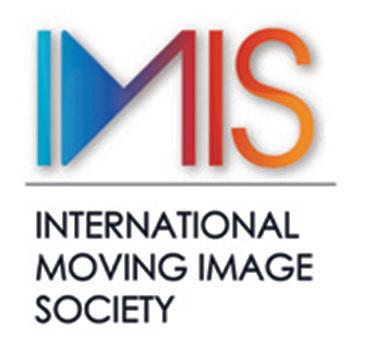
In the planning stages are a live webinar from Pinewood on The Trends & Developments in Motion Picture Cameras and workflow, a screening of a new feature film for members, their families and guests, inputs on motion capture and virtual production as well as other webinars.


We are delighted to open 2024 announcing the resounding success of ICTA’s annual Los Angeles Seminar Series, marking another milestone for our association.
The technical programming was outstanding, and our awards ceremony elevated the champions of our industry. The event was back to full capacity and held the spirit of normalcy that industry events are finally achieving post-pandemic. We’ll be spring boarding from this seminar to our US Summer Convention in Newport Beach, California. The Summer Convention agenda is being assembled and will have a mix of technical programming with a Pacific coastal vibe and all members are welcome. In between, we will have a reception at CinemaCon in April, and hope to see you there.
ICTA’s annual Los Angeles Seminar concluded on January 10 with a near-record turnout of over 200 people. Attendees included exhibitors, equipment dealers, consultants and others affiliated with theatrical exhibition.
Programming featured the usual balance of technical subject matters, business operations, and “state of the industry” insights. The featured keynote speaker was Michael O’Leary, CEO and President of the National Association of Theatre Owners (NATO). O’Leary’s keynote conveyed optimism for the industry, and he highlighted a renewed emphasis on the importance of open and honest communication among industry groups, especially vendors groups such as the International Cinema Technology Association and the National Association of Concessionaires.
Day one technical content was kicked off by an outstanding presentation from Tomlinson Holman on
“Compression Drivers, Horns, and Crossovers”. His talk provided a bit of history of these critical audio system components and their critical importance to the quality of sound we hear in the cinema. Mr. Holman also distributed a “preview” chapter from an upcoming book about Cinema Design.
One of the most informative sessions was a round-up of different methods and tools commonly used for cinema room audio analysis and measurement. Presenters included Jamie Anderson of Rational Acoustics (makers of SMAART), Michael Babb from Trinnov, Tim Holmes of AcoustX, Sunil Karanjikar from Harman, and Jay Wyatt of Meter Sound. This lively panel was moderated by Brian Vessa of Sony Pictures.
Two afternoon sessions focused on direct view LED screen technology for theatrical exhibition. A great review of the technology was delivered by Pete Lude of Mission Rock Digital, noting that there are presently 29 models of LED screens from 15 different manufacturers that have received


DCI certification; 10 new models in the past year alone. While the number of total DV-LED installed globally is still very small (likely under 60), the number of manufacturers means that costs are likely to come down, and the many challenges associated with installation will be addressed. In fact, such challenges were then discussed in a panel presentation led by Danny Pickett of BACP. Frank Tees (MiT), Tim Reed (Cinema Consultants), and Stuart Bowling (L.A.D. Consulting) who gave a great overview of some of the current challenges and how they can be addressed.
The highlight of day one was the annual ICTA Awards Dinner. The dinner included a moving tribute to the late Ray Boegner, president of Strong Global Entertainment, delivered by close friends, associates, and his wife Lulu and their young son. The third annual North American Cinema Awards were presented, winners as follows: Best New Build Cinema, Cinepolis Luxury Cinema in Inglewood, California; Best Refurbishment of an Existing Cinema, B&B Theatres Creve Coeur, Missouri; Best Use of New Technology, Emagine Entertainment, Batavia, Illinois. A special “Jury” award was also presented to FatCats, for their visionary approach as a total entertainment package, including bowling, food service, mini-golf, arcades, and cinemas. The evening was concluded with the presentation of the prestigious ICTA ICON of the Industry Award, this year given to Tomlinson Holman, inventor of the Lucasfilm/THX program and many other innovations
that have led to sound improvements in the cinema industry and others. Past winners of the ICON Award include the Will Rogers Motion Pictures Pioneers Foundation, and Ioan Allen of Dolby Laboratories.
Over in Europe, ICTA is in the middle of what will certainly be a busy year ahead. In addition to our seminar at the German Cinema Convention, we are planning our Barcelona Seminar Series and our ICTA EMEA Awards. This event will take place just before and during CineEurope. A brand new initiative we plan to pilot in Europe this year is the Cinema Technology Mentoring Scheme. The program is intended to provide skills development and career guidance to junior and mid-level professionals working in the cinema technology space.
This is a reminder to all ICTA member companies that our annual convention will take place this year in Newport Beach, California, July 21 through 24. The location for this year’s event is the beautiful Bayview Marriott Hotel, where we’ll once again feature informative business and technical sessions, interesting field visits to local industry-related facilities, and of course plenty of time for networking and socialising. More information including registration and lodging is available at www.icta-web.com
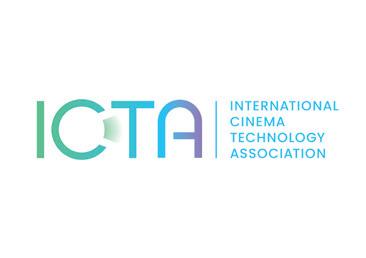
Not something which is necessarily in the wheelhouse of many readers of Cinema Technology - but something which undoubtedly has concerned many of the cinema owners and operators with whom they do business over a number of years – has been the general decline in the number and perhaps quality of British films that they are able to put in front of their audiences. The headline numbers are sobering. In 2023, British films made up less than 10% of national box office, the second-lowest figure in the last 20 years. In 2015, 33 British films made over £1m – in 2023 that number was down to 11.
That’s important for a number of reasons, quite aside from the obvious point that fewer films drawing in audiences means less money into the coffers for the people this Association represents. In truth the difference between a good and a great year for the UK sector is not the performance - or overperformance - of a small number of major studio titles; it is the contribution made by a wider range of titles, both in terms of maintaining a regular cinema-going habit and in drawing in wider and more diverse audiences for whom the major tent-poles may not be a draw. And of course, the lack of British films in particular means that we are not fully able to reflect our own national story or stories, and our audiences are not seeing their own experiences reflected on the big screen. This ongoing malaise is not something which has been ignored by Government or by policy-makers.
In my now increasingly lengthy tenure heading up the UK Cinema Association, I think I may have seen half a dozen or so Government-backed reviews of British film, British independent film or independent film come and go, with - it has to be saidlittle by way of tangible return. So it was with some small sense of déjà vu that I and my counterparts in film distribution and independent film production responded in late January to an
www.cinemauk. org.uk.

invitation from the Commons Culture, Media and Sport Select Committee to give evidence as part of their Inquiry into British Film and High End TV. To be fair, the last such by the Select Committee – some 20 years ago – had resulted in tangible change. And given that MPs on Select Committees in general make a habit of asking the difficult questions, and not shying away from challenging perceived wisdom, there was every reason to treat our appearance as a significant opportunity to address a number of misconceptions.
The most widely-held of these is that cinemas in general – but particularly the major circuit operators – are not interested in showing British films. This in truth seems a very strange accusation, suggesting that cinemas would not want to make available to their audiences films they might enjoy, see as relevant to their lives or even to be telling their stories.
Certainly when speaking to our members we know many share a frustration about their lack of ability to rely on domestic films to the same extent as their European counterparts, with British films accounting for less than 10% of total box office in 2023 compared to somewhere between 20 and 30% across other key competitor territories. As a result UK operators remain particularly vulnerable to unexpected impacts on the ‘supply line’ of films for the major studios such as seen as a result of the recent screenwriters’ and actors’ strike action.
One common (and perhaps understandable) response when this point is raised notes that there are hundreds of films outside of the studio slates released into cinemas each year. Certainly there were a significant number of British titles amongst the 1,000 plus films released theatrically in 2023, so surely, the logic goes, cinemas should be working harder to present and promote some of those titles on their screens?

